| Home>Kagura>Article |
Kagura and Folklore
The following text is a slightly modified machine translation and may have some unnatural parts.
Kagura and Folklore
About essentialism and constructionism in Kagura
Kagura and Folklore
==introduction==
What kind of image do you have when you think of Kagura? Maybe it's the name of the character? Kagura is a traditional Japanese performing art composed of music and mai (Swirling dance). The origin of Kagura is said to date back to Iwato mythology, and it is also the oldest performing art in Japan.
It was folklore scholars who pursued kagura in the field of scholarship. This article is a brief review of Kagura-related books. I will also cover Iwami Kagura, Geihoku Kagura, and Kanto Sato Kagura, Japan. In the second half, I will look at Iwami Kagura, which is often criticized as a show, from the aspects of essentialism and constructionism.
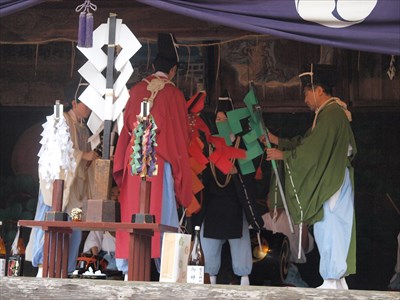
Haji-Ichiryu-Saibara-Kagura of Washinomiya Schrine
I am from the Iwami region of Shimane prefecture, where kagura is popular. When I was a kid, when the autumn festival season came, the sound of the Shinobue (Japanese transverse flute) echoed from the shrine, and I had the image of watching Kagura at night and spending the night while avoiding drowsiness. Is it impossible due to noise regulations in Kagura and Kanto at night? In Yokohama, where I currently live, there are only several shrines with kagura hall (kagura-den: stage for Kagura), and it is said that there are four Kagura companies, but overall it is a barren area of kagura.
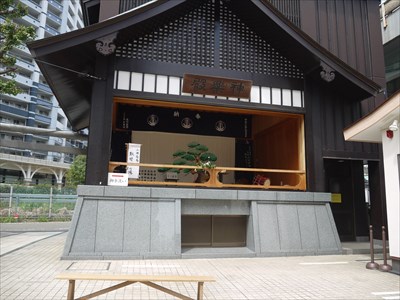
Kagura Hall (Kagura-den) at Suitengu Hiranuma Shrine
In the case of the Iwami region of Shimane prefecture, local companies gather at the civic hall and gymnasium to hold a co-starring convention for Iwami Kagura. Actually, I've only seen night Kagura and co-starring convention a few times, and I'm not so deeply immersed in it. I don't remember getting sweets from Ebisu-san anyway. But it's a happy memory of my childhood.
Many people may associate Kagura with a mythical drama. For example, if you search for "Iwami Kagura Orochi" on YouTube, you can watch "Orochi", which is a typical performance of Iwami Kagura. "Orochi" is now danced as the last performance in co-starring conventions. In addition, Orochi is a major performance in urban performances and foreign performances. It is based on the Yamata-no-Orochi myth, because it is basically a clear story in which a hero exterminates an evil dragon, and it is easy to understand even if you do not understand the meaning of the lines.
==Orochi and Iwami Kagura==
When you actually look at it, you can say that it is a kind of spectacle with many large snakes appearing. This large snake consists of a bellows-shaped body made of bamboo and Japanese paper called a Jado (snake body), which was developed in the early 20th century and can be said to be an innovation and creative destruction of Kagura. Since it was destroyed, there was one side that broke the tradition (until then, they wore scale-patterned costumes), but by getting a Jado, "Orochi" became a representative performance of Iwami Kagura. It has established that position.
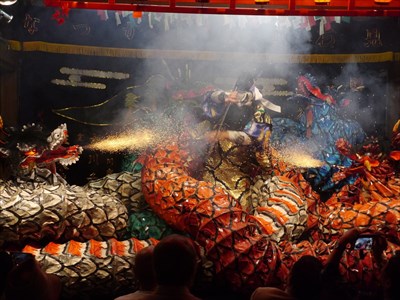
Iwami Kagura Orochi Susanoo and Orochi
It is said that it is still being handed down, but it is said that the 1970 Osaka Expo was one of the turning points for the spread of "Orochi". It was a magnificent one with eight big snakes appearing on the stage. At that time, the successors of traditional performing arts from other places who performed together said that they were "eaten by Orochi." It had such an impact.
Iwami Kagura gained national recognition at the "Orochi" performance at the Osaka Expo. Since then, appearance requests have come from all over the country, and business trip performances have begun. In recent years, Kagura has become a trend to attract tourists. In this way, the transformation of "Orochi" changed the appearance of Iwami Kagura itself.
On the other hand, researchers have expressed strong concern about the Kagura show. "Orochi" is a typical show. There are both merits and demerits in this, and in the next chapter I will consider essentialism / constructionism.
When I was in the first year of junior high school, my homeroom teacher was a local historian. He once criticized Iwami Kagura and said that the real Kagura is like Omoto Kagura. At Iwami Kagura, you will be on stage wearing a heavy dance garment embroidered with gold thread and silver thread, which costs one to two million yen. In Omoto Kagura, it is a traditional hakama with white as the base color. However, there are some people who make a living by making Kagura costumes, so I can't say unconditionally, but it is a fact that costumes are becoming more and more gorgeous year by year.
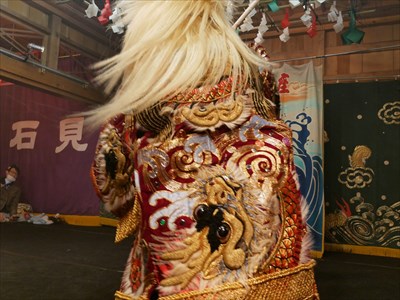
Iwami Kagura Jura costume of Oni demon

Hakama
By the way, the embroidery technique is said to have been brought back by the owner of a Kagura costume shop after training in Shikoku, where rural Kabuki is flourishing. It is a technique that cannot be easily imitated.
Currently, Kagura performances are held every weekend for about an hour to an hour and a half in the cities and towns in western Shimane prefecture. Kagura is now a tourism resource. A moderate view is to start with the entertaining Iwami Kagura and then lead to the more Shinto ritual Izumo Kagura and Oki Kagura.
==Lecture on Sato Kagura==
Returning to the story, I have lived in Yokohama for more than 20 years and have lived a life unrelated to Kagura, but with the development of the Internet, information has gradually come in. In 2007, I listened to a lecture on "The charm and tradition of Sato Kagura" at the Yokohama History Museum. The lecturer was Shigeru Takayama, Professor of Nihon University (at that time).
In this lecture, I learned the basics of Kagura. The etymology of "kagura" is a transliteration of Kamukura. Kamkura means the place where god is. And the ritual of calling a god to the Kamukura is called Kagura. In the so-called Iwato mythology in Kiki mythology, it is said that the origin of Kagura is that Ame-no-Uzume danced in a trance state (Kami-gakari) in order to recall Amaterasu who had withdrawn to Iwato (rock cave) for fear of Susanoo's violence. In fact, Iwato Kagura seems to be performed everywhere in Japan. Especially in Kyushu, Iwato Kagura is emphasized.
Although it is such a kagura, one turning point will come with the Meiji Restoration. A Shinbutsu bunri decree (the Kami and Buddhas Separation Order) was issued. The bearer of the kagura was the priest of the shrine, but since the kagura had the colors of Shugendo and Onmyodo, it is prohibited for the priest to dance the kagura. This is the so-called the ban on priesthood performances. In addition, it was forbidden to get an olacle in a trance state (Kamigakari). This caused many priests to withdraw from Kagura. Kagura was hit hard. On the other hand, at the end of the Edo period, the desire of the shrine's parishioners to dance kagura is increasing. In line with this trend, the bearers of Kagura became private-sector parishioners after the Meiji era. The priesthood would be inherited by teaching Kagura to the parishioners.
Kagura performances have also been controlled and a examination system has been introduced. It seems that this questioned the knowledge of ancient history and Shinto rather than practical skills. At this time, it is said that obscene acts and acts that desecrate god were prohibited. In this way, it is said that the Kagura performances were organized in the Meiji era and connected to the present.
There are some exceptional cases where the priesthood conveys kagura. A typical example is Omoto Kagura, which has been handed down in the Iwami region of Shimane prefecture. At Omoto Kagura, there is still an event to get a oracle in a trance state at the annual festival once every several years.
==The origin of Kagura==
Although it is not the content of the lecture, Shinobu Origuchi, a folklore master, thought that the origin of kagura was the Chinkon. Ancient people thought that life should be renewed on a regular basis because life declines over a period of time. Perhaps it comes from the sun's most declining at the winter solstice. Therefore, Origuchi defined the Chinkon to attach the good god to the body and to renew life. This theory is the established theory about the origin of Kagura today. It is also interpreted in Chinkon theory at the Daijo-sai, which is held when the Emperor becomes the throne.
==History of Iwami Kagura==
The Iwami Kagura, which is handed down in the Iwami region of Shimane prefecture, was already danced in the Edo period. It changed in the same way as Kagura in other regions under the various controls of the Meiji Restoration. The priesthood withdraws from Kagura due to the ban on priesthood performances. Therefore, the bearers of Kagura became the parishioners. Sometimes the priesthood taught the parishioners. In the 10s of the Meiji era, a movement to revise Iwami Kagura took place. This unified the script in which the verses were collapsed, and changed the lines from material to old-fashioned. In addition, a fast-paced rhythm was introduced, and the so-called eight-tone Iwami Kagura was born. So to speak, The eight-tone Iwami Kagura is a modern product.
==Kagura and Forklore==
The study of kagura will be described later, but it was first pioneered by Yukichi Kodera's "Study of Kagura as Art". This is followed by "Kagura Studies" by Masayoshi Nishitsunoi, a disciple of Shinobu Origuchi. In addition, Kotaro Hayakawa carefully fieldworked the Mikawa region and published his great book "Hana-Matsuri (Flower Festival)", which shocked the folklore society. Then, Yasuji Honda conducted empirical fieldwork on a nationwide scale to actually see Kagura, collect materials, classify and systematize them. After that, Kagura researchers in the Chugoku region made the following achievements.
It was folklore scholars who pursued the traditional performing arts Kagura as an academic discipline. One of the books I read is "Study of Western Japanese Kagura" written by Takatoshi Ishizuka, a folklorist from Izumo. Ishizuka also presided over the magazine "San'in Folklore". Ishizuka can be said to be the erudite scholar of Izumo.
"Study of Western Japanese Kagura" is an article that deals with Sato Kagura in Chugoku, Shikoku, and Kyushu, which is called Sato Kagura as opposed to the Mikagura performed in the court. Kinki Kagura is omitted because it is mainly a Miko Kagura (shrine maiden kagura).
There is Izumo style Kagura in the classification of Kagura, and it is said that it is distributed in Chugoku, Shikoku, and Kyushu. At the Sada Shrine in Izumo, the style of Noh was adopted from the Azuchi-Momoyama period to the early Edo period, and it was organized as the Nanaza (seven) Shinto ritual, Shiki Sanba, and ShinNoh. And the dramatization of Kagura began. And it is a common theory in the era when this book was written that the dramatization of Kagura spread throughout the country from Izumo. Some people may think of Kagura as a mythical drama. To elaborate a little more, Noh Mai dance, which was made into a play for the entertainment of ritual dance, began to be performed, but as time went by, the Noh Mai dance part became bloated. And it became a Noh-centered organization as it is now.
Ishizuka responds by saying, "Wait a minute," and gives his opinion. Ishizuka has been touring a wide range of Kagura in Chugoku, Shikoku, and Kyushu, and there are Kagura that are older than Izumo Kagura. In addition, it seems that the dramatization of Kagura had begun before the Noh style was adopted at Sada Shrine.
Among them, Ishizuka evaluates Shiromi Kagura in Miyazaki Prefecture. This can be said to be the secret in Ishizuka Kagura theory. In Shiromi Kagura, there is a dance of a performer who does not wear a mask (Hitamen). Then, the god who wears a mask appears and dances along with it. It is a style that repeats this. This form is called Kagura, where a god appears (Shintai Shutsugen). And Ishizuka thinks that Shiromi Kagura shows the ancient state before Kagura became a play.
For example, in Omoto Kagura in the Iwami region of Shimane prefecture, there is a performance called "The Mountain Great", and it is also called "Next to Tagusa". It means a performance that is performed after the ritual dance that purifies the stage called "Tagusa". By the way, "Mountain Great" is a comical content in which the congratulators (Nottoji) entertain the appearing Mountain Great, but the congratulators distort the words of the Mountain Great who speak in difficult mountain languages one by one. For example, mochi (rice cake) is called Buddha's ear.
In "Study of Western Japanese Kagura", Kagura of Chugoku Shikoku and Kyushu are classified as follows.
- * Kagura dancing with the goal of Iwato Kagura
- * Kagura that dances with the goal of Gogyo (Wuxing: Five Phases) Kagura (Prince Goro) (* Prince Kagura and desired division [Shomo-wake])
- * Kagura dancing to the Shogun
The goal is, in essence, the final performance. As mentioned above, Iwato Kagura is a performance based on the Ama-no-Iwato myth, but it is mainly distributed in Kagura of Kyushu . Performed before dawn is suitable for Iwato Kagura, which regains light from the darkness.
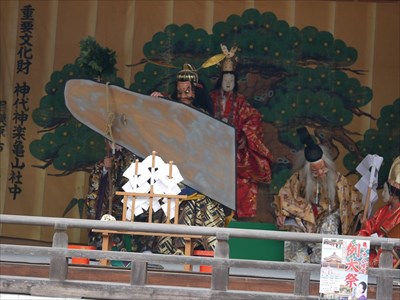
Kanto Jindai Kagura Ame-no-Iwato
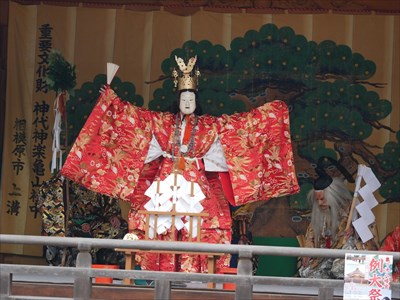
Kanto Jindai Kagura Ame-no-Iwato
Gogyo Kagura is the so-called Prince Goro Tale. The youngest brother, Prince Goro, came to the four princes who are the sons of King Banko (Pangu), the founder of all things, and who control the north, south, east, and south, spring, summer, autumn, and winter, and demanded that he also want his duties. However, it was refused. When King Banko died, he was still in the womb of his mother and was not given any duties. The angry Prince Goro challenged his four older brothers, but couldn't settle. There, Dr. Monzen entered arbitration. He subtracted the 18 days of the Doyo (the dog days) from each of the 90 days of the four seasons to make each 72 days, and when the Prince Goro was placed in the center, the arbitration was settled. This embodies the Ying-Yang Five Elements idea, and Iwao Yatomi, a local historian in Masuda City, Shimane Prefecture, called the Gogyo Kagura a "farmer's Philosophy."
Prince Goro Tale is incorporated into a ritual text called the Doku-Saimon (A congratulatory message to worship the god of the earth). The Doku-Saimon are read when purify the kamado (a traditional cooking stove), There, the gods of the earthen gods and the gods of the Gogyo (Five Elements) Kagura are syncretized.
Gogyo Kagura develops and grows especially in the Bingo region of Hiroshima prefecture and the Bitchu region of Okayama prefecture. It is said that in some regions it takes more than a full day to perform everything. From Hiroshima prefecture to Okayama prefecture, there seem to be many kagura performed with the goal of this five-element kagura. In Bingo Kagura, it was originally performed by a professional kagura master, and the debate was spectacular. However, it seems that it declined rapidly in the 1955's, probably because the mass media began to spread. By the way, in the Iwami region of Shimane prefecture, Iwato Kagura was brought first (* Iwato also means the beginning Kagura), and the last performance is Gogyo Kagura. In Iwami Kagura, Gogyo Kagura is titled "Gojin (Five gods)" and "Goryuo (Five Dragon Kings)".
The Doku-Saimon is also read at the Hanamatsuri (flower festival) in the Mikawa region of Aichi prefecture, but Prince Goro is a princess, that is, a woman. Since she is a woman, gorgeous items are given as a heritage of the Great Banko (Pangu), but her duties are better. The final form of the development of the Doku-Saimon is probably Princess Goro (Goro-no-Himemiya).
"Shogun" is a ritual dance and there is no clear story. The Shogun (general) seems to refer to the Tendai Shogun who appears in the Buddhist scriptures. Roughly summarized, it is a dance that exterminates evil spirits. This is also a valuable performance that can be in a trance state depending on the company. Aki-Juni-Jingi (twelve deities in Aki region) Kagura in Hiroshima prefecture are typical, but it can be said that it is an old kagura that has spread to the southern part of Kyushu. It is said that there is a record that Shogun dance was performed in Iwami Kagura in the old days, but it is not transmitted now. It is said that it is obsolete because it is a dangerous dance that enters the trance state. The video I watched on YouTube is "Shogun no Mai" by Yasui Kagura in Kochi prefecture. It does not enter the trance state, but you can see the action of going through the bow.
Next, looking at the element of "people" who conveyed Kagura, it is said that Yamabushi of Shugendo conveyed it, although it is remarkable in the Tohoku region. Yamabushi obtained a certificate of Yoshida Shinto, settled in a local shrine as a shinto priest, and transmitted Kagura. Ishizuka takes up a pair of a male Hosha and a female Myobu in Tsushima island as an example of western Japan. The remote islands have an ancient state where the Hosha is in charge of the accompaniment and the Myobu dances. In addition, Ishizuka traces back to the origin of the Hosha, and suspects that they are onmyoji who are scattered from the center to the regions. Onmyoji will also appear along with Yamabushi of Shugendo as the people who conveyed Kagura.
I watched Yanagi Kagura "Shiken (Four Swords)" of six-tone (Roku Tyoshi) Iwami Kagura on YouTube. The content is that four people dance in a narrow space under the canopy (Tengai), and it is thought that the ancient style of Kagura is preserved. It was in posterity that the stage was widely used.
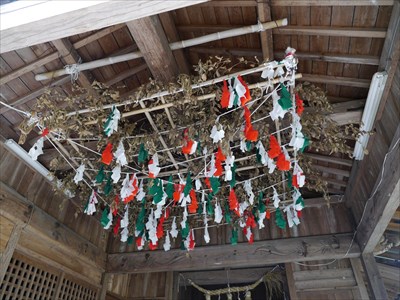
Canopy (Tengai)
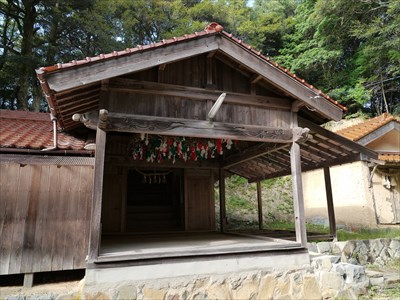
Kagura hall and Canopy
"Study of Western Japanese Kagura" can be said to be an appropriate book for an overview of Western Japanese Kagura. I would have liked the East Japan version if possible, but it is probably the limit that one scholar can look around. For ordinary Kagura researchers, one prefecture + α is the territory.
By the way, there is another researcher in Shimane prefecture who is familiar with Kagura. A man named Michio Ushio has left a book called "Kagura and Kamigakari". Ushio is the priest of a local shrine and the successor of Omoto Kagura who leaves the ritual of getting an oracle in trance state. It can be said that he is a born Kagura researcher. By the way, Takatoshi Ishizuka is also from a Shinto priest's family. Ushio graduated from Kokugakuin University before the war and helped publish Masayoshi Nishitsunoi's "Kagura Studies". After the war, he was a member of the Cultural Property Protection Council in Hiroshima, Shimane, and Yamaguchi. He has also made achievements in collecting rice field songs.
"Kagura and Kamigakari" mainly focuses on Omoto Kagura, which remains in the mountains of Iwami region, Shimane Prefecture, and Hiba Kojin Kagura, which remains in the Bingo region of Hiroshima Prefecture. Both are precious kagura that leave a ritual to get an oracle in a trance state. In Omoto Kagura, a snake is made from straw, and the Omoto god is possessed to the straw snake (the straw snake can be said to be Yorishiro [Things that possess god]) and shaken. Then, the priests messed up the Takudayu (Those who make a oracle) and put him in a trance state to get a oracle, then the festival ended, and the straw snake was wrapped around the tree to finish. Omoto God is not clear in appearance or personality, but is considered to be the fundamental god that controls all of nature.
In the mission, several people called Takudayu are selected in advance. Then, takudayu cleanses himself for about a week and faces the Kagura of the day. However, strangely, it seems that it is not always possessed by Takudayu, but also possessed by spectators. He seems to scream "Wow". Then, the priest asks the Takudayu, who has entered the trance state, about the fertility of the crops and whether there is a fire. He says, "It's a good harvest." The priest does not ask very complicated questions.
Entering a trance is exhausting, and it is said that even if it happens twice in life, it never happens three times. When entering the trance state, the person who holds the waist supports the body. If he does not do so, Takudayu may run at full power, and as a result, there are cases of people who died crazy. In addition, the trance state seems to enter by repeating a monotonous rhythm. It is also known that Ushio was taught the method of reversing the trance state.
The gods that appear here are not the higher gods that appear in Kiki mythology. It refers to the haunting Kojin gods and dead spirits called Misaki. It is difficult to define Kojin, but it is a spiritual deity in that it haunts if it is not enshrined.
At Hiba Kojin Kagura, a ceremony is held at the 33rd year of the ceremony for the souls of the deceased to join the ancestral spirits. In other words, a person becomes an ancestral spirit 33 years after his death, which shows a different view of life and death from the Buddhism of reincarnation. Before being influenced by Yoshida Shinto, it seems that the Jodo (Pure Land) Kagura was also executed, but it is only recorded and has not been passed down to the present day.
Today's kagura is becoming more and more dramatic and has become a popular pastime. In short, it's a countryside entertainment. However, if you go back to the origin of entertainment, you can see the importance of Kagura in that you can reach the view of life and death.
The roots of Iwami Kagura in Shimane Prefecture are Omoto Kagura. Since the performances almost overlap, it is easy to judge. Iwami Kagura is divided into six-tones (Roku-tyoshi) and eight-tones (Hattyoshi). The newer eight-tone, which was born in the Meiji era, has a faster tempo and more intense dance. If the six-tone sounds like "tontoko", the eight-tone sounds like "tokotoko". That probably matched the temperament of the masses on the coast of the Iwami region. Eight-tone kagura has spread, and now six-tone kagura with a relaxed tempo is a minority.
Ushio saw the current state of these kagura and complained that it was a kagura show. Kagura began to be made into dramatic, and gradually became popular. However, it is also true that the original simplicity of kagura has been lost due to the gorgeous costumes and the intense dance. He was sometimes asked to judge the Kagura competition, but he refused all of them.
"Kagura and Kamigakari" was edited by Masaru Iwata, who will be described later, instead of Ushio who was ill in bed. There is a fierce criticism of the eight-tone Iwami Kagura in "Kagura and Kamigakari". Ushio would eventually die of illness, so he really wanted to say that.
Kagura research has progressed in this way, but here a mutant researcher appears. It is Masaru Iwata, a Kagura researcher out of office. Iwata's main business is a postal civil servant, and his educational background is that he graduated from an old junior high school, so it is equivalent to a high school graduate now. Iwata self-taught to master higher education and established his own Kagura theory.
An old document of Kagura in the early Edo period was discovered in Hiroshima Prefecture. This is a Kagura Noh book, Bingo Tojo Kojin Kagura Noh book, which is owned by the Miyawaki Tochigi family in Tou, Tojo-Town, Shobara-City, Hiroshima. It was not Iwata's achievement in itself, but Iwata went to the old family where this old document was left and actually saw the old document.
Iwata was born in Hiroshima prefecture and moved around the Chugoku region because of his work. He seems to have been close to Michio Ushio and Takatoshi Ishizuka. He probably saw Hiba Kojin Kagura in Hiroshima Prefecture and Omoto Kagura in Shimane Prefecture, where his creativity leap was born.
Iwata categorized Kagura into an oracle type and a geist forced type. It seems that this was from reading Max Weber's "Sociology of Religion", but Iwata's original idea is to apply it to Japanese Kagura.
The olacle type is prominent in the performance of "Seki" in Aki Juni Jingi Kagura in Hiroshima Prefecture, and a Oni demon named Arahira comes to Japan and talks for a long time to appeal how amazing he is. However, since Japan is a land of the gods (shinkoku), it is defeated and a blessing wand (magical tool) is presented. In summary, it has the motif of a god's alone talk that came out with the dance and the gift of a magical tool. Then God dances the blessing and the worship is over.
The geist forced type is prominent in Omoto Kagura and Hiba Kojin Kagura, but it is classified into the type that converts evil spirits into guardian spirits and worships them, and the type that possesses them to Yorishiro and rejects them.
Iwata's theory of calming and rejecting geist is a direct challenge to Shinobu Origuchi's theory of chinkon in Kamukura (place where there is a god), which was a popular interpretation of the origin of Kagura. The Kamukura chinkon theory is an interpretation that the good god is attached to the body and the life is renewed by keeping it.
These classifications can never be imagined just by looking at the doramatic Kagura, and it seems that the territory of the area extending from Hiroshima prefecture to Shimane prefecture was the mother of the idea.
In addition, Iwata argued that Japanese shamanism is not something that a shrine priest enters in the trance state alone, but a pair of a person who lets another person enter in the trance state and a person who enters in the trance state. In Kiki, there are cases where Emperor Chuai plucks a koto (Japanese harp) and Empress Jingu is in a trance state fortune-telling.
It's not hard to imagine that Iwata's Kagura theory was a hit. Iwata published his articles in magazines such as "Sanin Folklore," "Hiroshima Folklore," and "Okayama Folklore," but it can be seen that the magazines at that time were full of energy.
In addition, these achievements were announced in the five years of the 1970s, and it can be said that Iwata achieved results that surpassed the professional in a very short period of time. These articles are reprinted in the book "Consideration on the origin of Kagura (Kagura Genryu Ko)".
There are also criticisms. A scholar named Haruo Suwa is in "History of Comparative Performing Arts between Japan and China", and a researcher named Takahiro Inoue is in a paper "About the method of studying Kagura Saimon (congratulatory texts), focusing on the theory of Masaru Iwata and Hiroko Yamamoto", and "Festival studies of Shimotsuki (11th month of the lunar calendar) Kagura". In each of the books, Iwata's theory is critically examined.
The Suwa theory categorized Kagura into motifs of pseudo-death rivaval such as Iwato mythology and Mikawa's Hanamatsuri (Flower Festival), and motifs of spiritual exorcism that calm the gods who curses, such as the Doku-Saimon. It is a form like an eclectic theory between the Origuchi theory and the Iwata theory. Basically, it is an idea that the motif of pseudo-death revival has existed since ancient times, and it is thought that the motif of spiritual calming was added in the Middle Ages.
Inoue's theory points out that Kagura's olacle type and geist forced type cannot be clearly separated, and that both elements have ambiguity.
There are criticisms, and I don't think everything is right. He tends to forcibly apply and interpret his theory. This is because the interpretation of the Iwato myth is an acrobatic interpretation in which Uzume is possessed by Susanoo and rejected if it is a theory of calming and rejecting geist. Also, when I read the Bingo Tojo Kojin Kagura Noh book, I felt that there was a problem as to whether the Iwata theory could be simply applied to Noh Mai dance. However, creating a platform for discussion was something that no one else could have done.
Iwata again strikes a challenge to Origuchi folklore in the following "Kagura Shinko (New consideration about Kagura)". Consideration will proceed depending on whether "鎮魂" is read as Tamaful or Tamashizume. Furthermore, to summarize the trance state in one word, it is "憑", but Iwata considers "憑" separately when reading it as Kakaru, Tsuku, Yoru, etc. This is an attempt to trace Kagura from the Middle Ages to ancient times. I can't say that I understand it at all, so I'll limit it to this level, but it seems that there was a next concept in addition to the achievements of "Consideration on the origin of Kagura (Kagura Genryu Ko)".
However, Iwata published "Kagura Shinko" and died two years later at the age of 69. He seems to have died shortly after becoming a part-time lecturer at Waseda University. He wouldn't have had enough time to be criticized in two years. It is regrettable that he died at a young age as a scholar.
There is a statement in "Kagura Shinko" that he actually wanted to interact with Shinobu Origuchi. That is probably Iwata's true intention that he could not go on to university due to family reasons. In fact, Takatoshi Ishizuka was in contact with Kunio Yanagida and Michio Ushio was in contact with Shinobu Origuchi, so it was not impossible for generations.
As mentioned above, we have seen Kagura from Shimane prefecture to Hiroshima prefecture. In my case, I was able to greatly change my perception of kagura by reading "Consideration on the origin of Kagura" "New consideration about Kagura " "Study of Western Japanese Kagura," and "Kagura and Kamigakari".
==Sato Kagura in the Tokyo metropolitan area==
In this way, it was a reading-oriented Kagura experience, but with the development of the Internet, information on Kanto Kagura has come to be popped up, and I was able to appreciate some of the Kanto Kagura.
At Jindai Kagura in Yokohama, I was able to see Miko Mai(dance of Shrine Maiden) and Urashima Taro. Kagura is an image of a mythical drama, but when I saw Urashima Taro, I was impressed that nursery tales were allowed. In fact, it seems that Sato Kagura of Edo has performances such as Momo-taro, Urashima Taro, and Hare of Inaba.
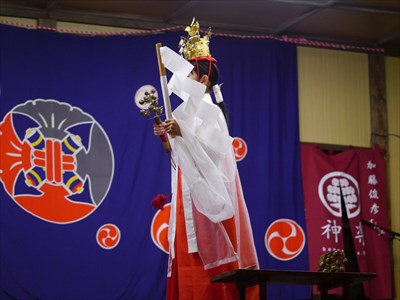
Kanto Jindai Kagura Miko-mai
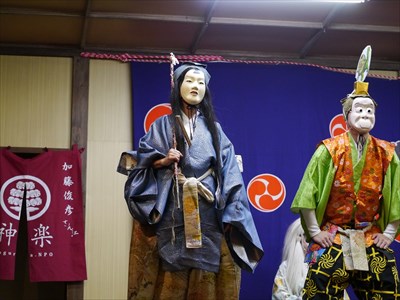
Kanto Jindai Kagura Urashima-Taro
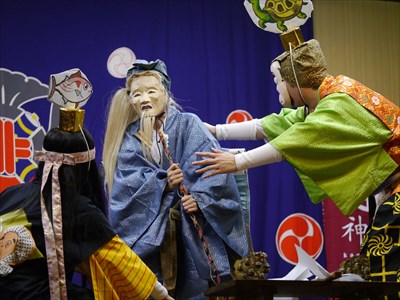
Kanto Jindai Kagura Urashima-Taro
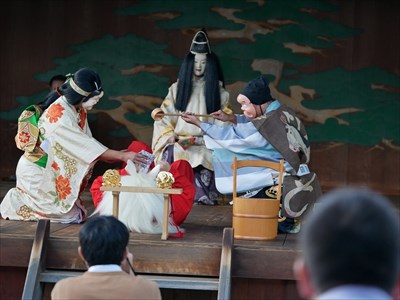
Kanto Jindai Kagura Hare of Inaba
After that, I went to the "Sato Kagura in Edo Viewing Party" held at Mamiya company in Tokyo. This is held every year, and I was able to see the Sato Kagura in Tokyo. "Ne-no-Katasu-Kuni (Ne-no-Katasu country means the country of the dead)" was a content in which various trials were imposed in order for Onamuji (Okuninushi) to visit Susanoo in the Ne-no-kuni and receive his daughter, Princess Suseri. Although it was mainly a mythical drama, Sato Kagura in Edo is basically a silent drama with few lines. The meaning is conveyed by a gesture called "Tegoto (a hand word)".
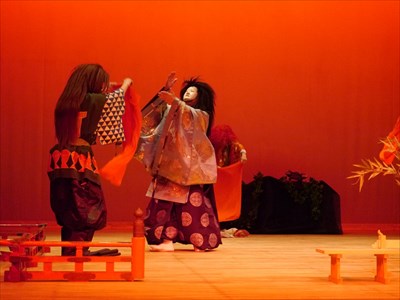
Kanto Jindai Kagura Ne-no-Katasu-Kuni
Actually, as a person accustomed to fast-paced kagura, I was worried at first whether I could enjoy slow-tempo kagura, but when I actually saw it, I enjoyed it without any problems.
And I was able to appreciate the Haji ichiryu Saibara Kagura at Washinomiya Shrine in Washinomiya, Kuki City, Saitama Prefecture. It is the Washinomiya Shrine that became a sacred place in the anime "Lucky Star". It seems to be the origin of Kagura in the Kanto region. The Kagura at Washinomiya Shrine was a ritual dance, and there was also the Iwato Kagura, but it was not a dramatic composition. It seems to express the gesture of god. A short performance called "Ha Kagura" is inserted between the performances. This is a shrine maiden dancing, and the day I saw it was the last performance of the Ha Kagura (maybe they just forgot to turn over the paper with the name of the performance on the turning table). However, I had the impression that women are playing an active role unexpectedly. The performance called Shakumai is performed by a shrine maiden and is brilliant.

Washinomiya Shrine Shaku-mai
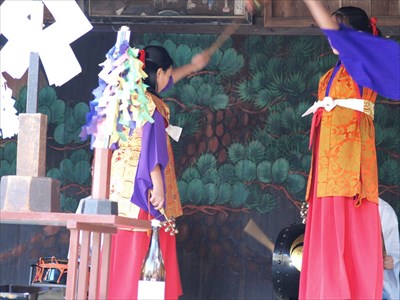
Washinomiya Shrine Shaku-mai
I was also able to appreciate the Banda Jindai Kagura at Kamegaike Hachimangu in Sagamihara City, Kanagawa Prefecture. It was a long-awaited first appreciation because it was canceled due to a typhoon the previous year. Kagura begins with Sanbaso, Daikoku-sama, and Okame / Hyottoko double-sided dance, and then "Ame-no-Kaeshiya (Heavenly Return of Arrow)". Ame-no-Waka-Hiko sent from Takamagahara urges Okuninushi, but he falls in love with Okuninushi's daughter Shitateru-hime at first sight. It is a synopsis that the pheasant who came to see them is shot with a bow and arrow, and Ame-no-Waka-Hiko himself is also shot back and dies. Rather than ending the kagura with tragic content, the story ended with a bright content in which a modoki named Tari then met with Okame on the road and repeated humorous acts without giving up to each other. Since it is a Kanto Sato kagura, it is basically a silent play, but it was performed while explaining with a microphone.

Kanto Jindai Kagura Ame-no-Kaeshiya
In April 2019, I was able to appreciate the Daidai Kagura at Shinagawa Shrine. It is said that the spring festival is held every year on the third Sunday of April (to be exact, the Sunday after April 15th). Daidai Kagura basically goes around the stage clockwise. When they step out, they feel like they're jumping their heels back and then slipping. I don't know if it's Henbai (magical steps), but there were many actions that they stepped on the floor. This may mean trampling the earth and calming the spirits. It was basically a ritual dance, and even the last dance based on Umisachi Yamasachi (Sachikae no Mai) was not made into a play. They performed six performances in about two hours. With this, I have seen seven performances of the Shinagawa Shrine's Daidai Kagura along with the Sato Kagura in Edo viewing party. It's a good number.
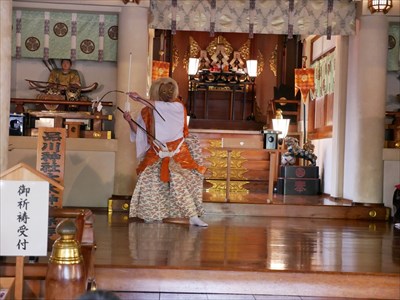
Shinagawa Shrine Daidai-Kagura Ya-Tenko

Shinagawa Shrine Daidai-Kagura Sachigae-no-Mai
In June 2019, I watched the second performance of "Kanagawa-no-Okagura" at the Nigiwai-za Hall in Yokohama City. All four companies in Kanagawa Prefecture gathered to perform "Goshugi Zanmai," "Momiji-gari," "Yakumo Shinei," and "Tenson Korin." In "Goshugi Zanmai", Sanbaso first appears to cleanse the stage. "Momiji-gari" is based on a Yokyoku and is a Oni demoness extermination of Mt. Togakushi. "Yakumo Shinei" is the extermination of Yamata-no-Orochi. Orochi wears the same costume as a human being, and the pre-Jado (snake body) performance form that is popular in the Chugoku region remains. After "Tenson Korin" was over, Sarutahiko remained and ended with "Sanjin no Mai (dance of mountain god)". This performance was organized by the Edo Sato Kagura Performance Student Executive Committee, and is a mixed organization consisting of student volunteers and general volunteers. They hold performances in Saitama prefecture every year, and it was the first time in nine years that they performed in Kanagawa. It seems that it was realized because there was an intention to hold an event in the first year of Reiwa.

Kanto Jindai Kagura Goshugi Zanmai with Sanbaso
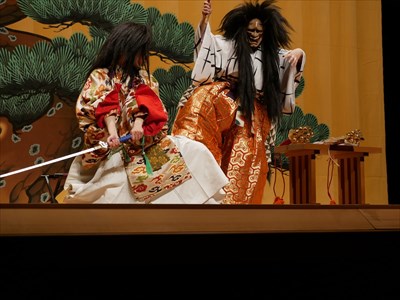
Kanto Jindai Kagura Momiji-Gari

Kanto Jindai Kagura Yakumo-Shinei Orochis
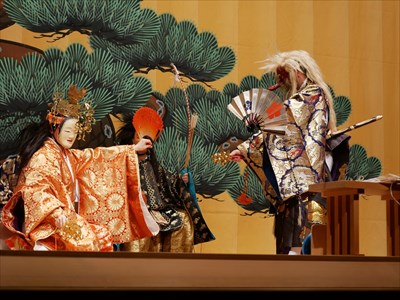
Kanto Jindai Kagura Tenson Korin
In the summer of 2019, I was able to appreciate the dedication kagura, but the Kanto Sato kagura has a long intermission. It takes about an hour. It is unavoidable because it takes time for the kagura master to take a break and dress up, but the audience changes during that time. Also, since the dedication kagura belongs to the parishioners, the shrine does not actively promote it.
A picture is worth a thousand words, and I was able to gain the backing of my knowledge by actually seeing the Kagura in the Kanto region, but the elements of battle are less than in the Chugoku region. It can be said that it is faithful to Kiki mythology. By the way, it seems that the behavior of Henbai is common in the Kanto Daidai Kagura. Henbai, also translated as a magical step, is a spell that calms the earth.
In addition, there is a strong stepping motion in the Kanto Jindai Kagura (Kagura that mainly plays mythological plays), but is that a Henbai? When I asked, I got the answer that the underfloor of the kagura hall is hollow, so we are making a deep bass sound by stepping hard.
In addition, in Kanto Sato Kagura (Jindai Kagura), the existence that plays a humorous role called Modoki occupies a large position. It seems that the etymology is "modoku" (to imitate). It seems that Modoki often acts as a servant of god. In the Chugoku region, Chari plays a humorous role. Chari makes you laugh with a talk, while Modoki makes you laugh with a gesture.
Unfortunately, Kanto Sato Kagura is a silent drama, so there is no such thing as an oral script. You can't enjoy the literary way of reading a script. For example, Yasuji Honda's "Traditional Japanese Performing Arts" series also included a list of retained performances. In recent years, the number of explanations using microphones has increased, and there are script explanations using microphones, so it may become possible to enjoy literary arts in the future.
By the way, although it is a book related to Kanto Sato Kagura, the performance program "Fun and easy-to-understand Edo Sato Kagura Performance" series of the Edo Sato Kagura Performance Student Executive Committee is held in the National Diet Library. Kagura performance commentary, history of the company, interviews / contributions with related parties, musical accompaniment (ohayashi), mask collection, costume commentary, dressing room, subtitle commentary, activity records such as student visits to sponsor companies, roundtable discussions, etc. A comprehensive collection of various aspects of the performance with color photographs, so that you can see where to look in the Kanto Sato Kagura.
The highlight of Kanto Sato Kagura is the dance of a god and a goddess (Tsure-Mai). In addition, as a promised dance, there is a Hakobi dance that is performed when a servant, Modoki or Okame, brings alcohol. At that time, a light musical accompaniment called "Nimba" is played.
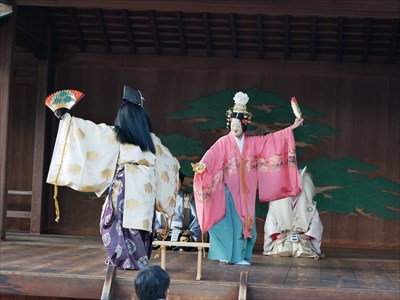
Kanto Jindai Kagura Hare of Inaba Tsure-Mai
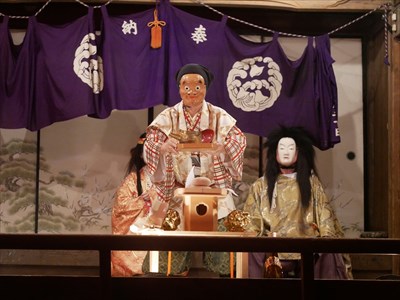
Kanto Jindai Kagura Hakobi-no-Mai
I think the charm of Kanto Sato Kagura is due to the flute (Shinobue). The playing style that makes heavy use of the back sound of "hii" is probably not found in systemized Western instruments. When the back sound echoes and the performance begins, the stage tightens at once. It is a sophisticated musical accompaniment.
In addition, it seems that there is no Kagura song in Kanto Sato Kagura. Saibara is sung at Washinomiya Shrine, but other than that, it seems that it is not seen especially at Jindai Kagura. At least Dotori (the main player) doesn't sing. Regarding this, it seems that the Kagura song was stopped by the Kagura revision in the Meiji era.
As far as I can tell, I think that Jindai Kagura in the Kanto region lacks three elements: Kagura song, canopy, and Gogyo Kagura (Prince Goro). It can be inferred that Yamabushi's involvement in the training was geographically weak. This is probably the case with Jindai Kagura, which originated in Edo and has a strong entertainment color, but the same tendency may be seen in Daidai Kagura. As mentioned above, Saibara is sung at Washinomiya Shrine, but it was not the Daidai Kagura at Shinagawa Shrine. There was no canopy. Gogyo Kagura is a Kagura that Yamabushi has handed down, and seems to exist in the periphery of the Kanto region. At Washinomiya Shrine, there are performances in which the four gods appear (Urayasu Yomo no Kuni Gatame), but the five gods do not appear. It is probable that the Gogyo Kagura was revised to the Shinto style.
The "Edo Sato Kagura Viewing Party" in Mamiya Shrine was held in Shinagawa's Rikkoukai Hall, a small hall with a capacity of about 250 seats, but the hall was almost full for free. The performance of "Kanagawa no Okagura" was mobilized at the Yokohama Nigiwai-za Hall for a fee of about 400 people, so it seems that the number of core Kagura fans in the Tokyo metropolitan area is only a thousand. It is said that the number of spectators in small theaters is said to be "the wall of 3,000 people" in contemporary theater, so it will be even smaller than in small theaters.
It is different from Kagura, which has many old people, because many of the customers of theaters held in small theaters are young women. While cherishing the existing fixed customers, we will gradually aim to expand it. And how to attract children is also considered to be one of the issues. I will discuss later why children are important.
==Kagura in Hiroshima Prefecture==
Another example is Hiroshima prefecture. Hiroshima Prefecture is also a land with a lot of kagura. Kagura with roots in Iwami Kagura is popular in the Aki region, especially in the Geihoku (north Aki) region. Therefore, academically, Geihoku Kagura is classified as Iwami Kagura.
As for how popular it is, for example, there are single-shot dramas such as "Mae! KAGURA Hime (Dance! Kagura Hime)" produced by NHK Hiroshima Bureau, and manga based on Geihoku Kagura such as "Himawari (Sunflower)", "Kagura Mau! (Kagra Dances!)" And "Hokago Kagura vibes (After School Kagura Vibes)". It also has the power to mobilize spectators to fill the large hall in Hiroshima City. In the summer, Kagura Koshien, a national co-starring convention for high school students, will be held in Akitakata City.
The Geihoku region is a region where the Jodo Shinshu sect is flourishing, and it is said that miscellaneous work and miscellaneous belief are eliminated, and it is conceivable that there was no room for Kojin worship. I don't know what it was like during the Edo period (* I know that Arahira was danced in the 16th century), but at the end of the Edo period, Iwami Kagura was taught from the Iwami region, which is adjacent to the Geihoku region. It is classified as Asuna-Te and Yakami-Te (Te means technique) depending on the place of origin. Both are place names in Ochi-County, Shimane Prefecture. This is called the old mai dance (KyuMai).
I watched Kajiya company's "Human Sacrifice" and "Suzukayama (Mt.Suzuka)" on DVD. "Human sacrifice" is the extermination of monkey gods. "Suzukayama" was about Sakanoue Tamura Maro fighting with a blind Oni demon while pulling a string (* Suzuka Gozen will not appear). I don't know if it's six-tones, but it was a slower tempo than eight-tones. There was a high-speed turn (Hiramai). The Kajiya company is an organization that has a great influence on the companies in the Geihoku area, and I was impressed that "this is Asuna-Te".
Geihoku Kagura had a breakthrough after the war. Japan came under the control of GHQ due to the defeat of World War II, and Kagura was also subject to ideological control. As a result, it became impossible to dance the mai with the color of the Land of the gods thought. It seems that there was a case of NG because the winged Oni demon (Jinrin) reminded them of B29.
Therefore, a creative kagura that avoids censorship was born. I also read Junzo Sasaki's "Kagura Script Collection", which is a creative kagura with a strong battle element and a focus on Oni demon extermination. Some of them are based on the myths of Yamato Takeru and Emperor Jimmu, but the most popular ones are Minamoto no Yorimitsu and the big four's Oni demon extermination and Tamamo-no-Mae's evil fox extermination.
There is a performance related to the Iwato myth called "Ame-no-Kaguyama", which has almost the same content as the "Yama-no-Kami (Mountain god)" of Izumo Kagura, and should be called the back story of the Iwato myth.
The story of "Yama-no-Kami (Mountain God)" is as follows. As Amaterasu withdrew into Ama-no-Iwato, the world was struck by darkness. Eight million gods consult with each other in an attempt to revive Amaterasu, and hold a festival with various items such as mirrors and magatama (* It is a former story to here). Among them is Sakaki (green leaves. branches of sakaki are used in Shinto observances.) of Mt. Ame-no-Kagu, but a certain god tries to take up Sakaki of Mt. Ame-no-Kagu, and the mountain god who looks at it asks him. There, he is chased and chased, but when he explains who the captive god is and what he is doing to get Amaterasu out of Iwato, the mountain god falls down. Instead, a treasure sword is given, and the mountain god purifies all sides with a sword to exorcise a demon (Akugiri).
Akugiri are highly Shinto ritual, but in "Ame-no-Kaguyama", a battle with the genie is added at the end, so it must be said that it is a redundancy. This group of creative kagura is based on Noh, Kabuki, Otogi-zoshi, etc, so the origin itself is not bad.
The creative kagura created after the end of the war is called Shin-mai (new Takata Mai dance), and it became very popular in the Geihoku region of Hiroshima prefecture. On the other hand, some companies received the aftermath. The Kagura called Aki Juni Jingi, which is transmitted to the western part of Hiroshima Prefecture, was hit. The Juni Jingi Kagura is not a dramatic composition and has a strong element of ritual dance, but it has been overwhelmed by a new mai dance that has a story and a fast tempo and a intense dance. It seems that the current situation is that some of the companies that dance the Juni Jingi Kagura are adopting new mai dances for their survival.
A video of the Juni Jingi Kagura is also available on YouTube. "Yatsuhana (八ツ花)" is a beautiful dance. It looks like a flower when viewed from above.
By the way, Junzo Sasaki, the creator of Shin-mai, emphasized the existence of Chari. Among them, "Modori-Bashi (Bridge)" and "Akko (Evil Fox) Den (tale) Part 2" are popular programs. Umbrella seller Zenbei and Chinzei Osho play an active role.
"Modori-Bashi" is the content that Watanabe no Tsuna, the big four of Minamoto no Yorimitsu, cuts off one arm of the Oni demon at Ichijo Modori Bridge. "Akko Den Part 2" is a story that Chinzei Osho welcomes Tamamo, who has escaped to the Nasu Highlands after revealing her true identity.
In Hiroshima prefecture, there are many competitions that are not co-starring conventions. It also means giving superiority or inferiority to Kagura. Competing has the advantage of improving the level, but on the other hand, it also has the aspect that inexperienced people cannot dance on the stage.
By the way, in Geihoku Kagura, it is the mainstream to make up with a real face (Hitamen) without wearing a mask. It is also said that this is influenced by rural Kabuki or popular theater. If the performer is a real face, there is an advantage that the lines are easy to hear. When the performer puts on a mask, the voice becomes muffled and it is difficult to hear the lines. Instead, the element of wearing a mask and transforming both physically and mentally is diminished.
I have to point out that Shin-mai (New Mai dance) in Hiroshima Prefecture has little Shinto ritual because of its origin. I also watched "Takiyasha-Hime" on YouTube, and I felt that it was a production that doubled the "Jinrin" of Iwami Kagura. In "Jinrin", the action of two gods standing on one leg and turning around is the highlight. On the other hand, in "Takiyasha-Hime", four people turn around. It is not a dance at the kagura hall, but a production that clearly assumes that they will dance on stage.
By the way, "Jinrin" is the content that Emperor Chuai (husband of Empress Jingu) exterminates the evil Oni demon called Jinrin who has led a large army from the country of Silla. The source is "Hachiman Gudo Kin", which was triggered by the Mongol invasion. You can see the idea of defending foreign enemies in terms of being influenced by the Mongol invasion. "Takiyasha-Hime" is the content of Taira no Masakado's daughter, Satsuki-Hime, who plans to take revenge.
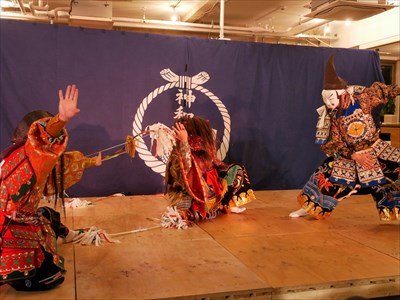
Iwami Kagura Jinrin
Besides, I saw the promotional video of "Mae! KAGURA Hime" on Twitter, but I thought that the heroine was spinning around in the practice scene and it was a ballet. For those who are doing slow-paced kagura elsewhere, it may seem strange.
In other words, it can be said that Geihoku Kagura in Hiroshima Prefecture is the most sharpened Kagura. There are some doubts, however, the fact is that it is popular because of its fast tempo and the story of poetic justice.
When I actually see the Kanto Sato kagura, I think that the kagura in the Geihoku region of Hiroshima prefecture is battle-oriented. As a result of incorporating a great deal of narrative, it deviates from mythological drama. It can be said that the ritual dance is neglected and the Noh Mai dance is overemphasized. Iwami Kagura is also mostly focused on exterminating Oni demons, but even so, they also hold performances without elements of battle, such as "Ebisu" "Iwato" "Yachimata" "Kifune" "Gokoku-Tanemoto (origin of five grain's seeds)" "Kakko" "Kirime" "Shijin (four gods)" and "Shiken (four swords)". In the Kanto region, there are also non-mythical plays such as "Momiji-gari" and "Shinken Yujo" that are derived from Noh.
This is nothing new, and there is an anecdote that a great folklore teacher once laughed that Kagura in the Chugoku region was all about Oni demon extermination. In other words, it was not seen as a decent research subject. On the flip side, it also means that the kagura that calms and rejects geist was not yet known.
From the aspect of Kagura masks, there are various Oni demon masks in the Kagura masks of Geihoku and Iwami regions. On the other hand, in Kanto, there are only two types, red Oni demons and blue Oni demons, and their variations. By the way, Iwami Kagura and Geihoku Kagura use papier-mache masks made of Japanese paper. It is lighter than a wooden mask. In the Iwami region, Sekishu Japanese paper is a special product. In addition, the creator takes the mold of the mask with clay. It is said that the technique of making dolls, which is a specialty of Hamada City called Nagahama Doll, is applied to it. With such a background, the papier-mache mask is used.

Iwami Kagura Mask

Iwami Kagura Mask

Iwami Kagura Mask
In Hiroshima, the Kagura is called Hiroshima Kagura, but in fact, it is the Geihoku Kagura that is active in Tourism Kagura, and There are the other Kagura in Hiroshima, such as Aki Juni Jingi Kagura and Hiba Kojin Kagura and Bingo Kagura and the Kagura of the Geiyo Islands, but it seems that it is just a way to borrow the authority of the historic Kagura.
I watched "Ame-no-Kaguyama (天の香具山)" by Nakakawado company on YouTube. I watched it, but the result was different from what I expected. When I looked it up, Nakakawado company's "Ame-no-Kaguyama" was a creative performance, and it was the same up to the point of reviving Amaterasu from Iwato, but the subsequent development was different, and Princess Yayoi tried to bring back Sakaki (green leaves and branch) from Mt.Ame-no-Kagu. However, the evil gods kill the princess Yayoi and rob Sakaki (* an unusual development in Kagura where the god is killed). There, Yamatsumi and his daughter Atatsu-Hime (Konohana-Sakuya-Hime) regained Sakaki. The content has been modified.
The Nakakawado company is an organization that hosts what is called Super Kagura, and is a famous organization in Hiroshima that likes creative kagura.
At the end of "Ame-no-Kaguyama", instead of using a sword to purify on all sides, it is purified with Gohei (staff with plaited paper streamers). Despite the fact that the original "Ame-no-kaguyama" has lines such as purifying all sides with a sword (reflecting Akugiri). Perhaps the reason for the change from purifying with a sword to purifying with Gohei is that the sword was smeared with blood in the battle. It seems that it was forced to change by making it a battle development. It is said that the gods of evil arose when Iwato was closed, so I think there may be such a development, but I also feel that the original meaning has been lost.
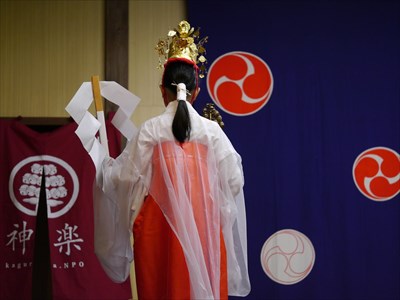
Gohei
Creative Kagura itself is not prohibited. However, if the content of Kagura is modified too much, there is a danger that it may become "Can it be called Kagura?". In addition, Super Kagura is aiming for performing arts that goes beyond the framework of Kagura. Therefore, it is a "Super Kagra".
By the way, in Super Kagura, it seems that the canopy, which is an important stage set of Kagura, has been removed for the rendition of flying the neck. It itself comes from the operation of pulling the canopy.
At Kakizawa company in Atsugi City, Kanagawa Prefecture, attempts are being made to use music for programming. The content itself does not seem to depart from the myth. It is important to pay attention to how the attempts in the east and west will develop.
I had the opportunity to remotely attend a seminar held in Hiroshima (delivered on January 25, 2021). Currently, there is a momentum to support Geihoku Kagura with the public and private sectors. Geihoku Kagura is still overrun, but the parties were eager to create new Kagura.
The attraction of Kagura in Hiroshima Prefecture is that there is diversity in each region. Hiroshima has everything from Kami-gakari (Being in a trance) to Super Kagura. Various kagura are transmitting their charms.
==Why Kagura Shows are popular==
The reason why Iwami Kagura and Geihoku Kagura, which are often criticized as "it is a show", is still popular, but I think it is because the tempo is fast and open. When Iwami Kagura was introduced on TV, some people described Iwami Kagura as 8 beats. Another said it was jazz (improvisation) rather than rock. In the book "New book that meets Kagura, songs, musical instruments, accompaniment (ohayashi)" by Toshimi Mikami, Iwami Kagura has reached BPM 200, and it is said that it is close to rock. Eight-beat music swept the twentieth-century music scene. I think there is something in common with that.
Words such as "dynamic" and "brave" are often used to describe Iwami Kagura. These qualities may attract people's hearts.
The eight-tone Iwami Kagura has a fast tempo and a strong dance, so the dancers are mainly in their twenties to forties. They will shift to accompaniment as they get older. On the other hand, in Iwami Kagura, which has a slow tempo and a six-tone tone, they are different in that they can act as dancers even when they are old.
By the way, the accompaniment of Iwami Kagura consists of a O-daiko (big drum), a Shime-daiko (side drum), an atarigane (Chanchiki: mini cymbal), and a Shinobue (flute). The player of the big drum leads the performance as a Dotori (Leader). Since they sing kagura songs, it seems that people who are good at singing used to act as the Dotori. In recent years, women often act as flutes. Women are gradually expanding into the world of Kagura. Atarigane is a seemingly modest role, but it has the meaning of slamming the rhythm of kagura into the body.
In Shimane and Hiroshima prefectures, it is customary for parents to show their children Kagura. Fast-acting people have been accustomed to it since they were babies. A multi-generational cycle has been established in which a child who grew up watching kagura becomes an adult and becomes a parent and shows the kagura to their child (grandchild). No matter how much it was said to be a "show," Iwami Kagura wasn't surprised because it had established such a cycle.
I watched the online extension course "Japanese heritage of Shimane, the world of myths where gods and Oni demons are moving, Kagura handed down in the Iwami area" (delivered on November 15, 2020). The lecturer is Satoru Hyoki, a professor at the Faculty of Arts and Letters, Seijo University.
Professor Hyoki evaluates Iwami Kagura's children's kagura as follows.
- * He thinks that young people's kagura is important because it conveys the charm of kagura to younger children and nurtures younger children who are continuously interested in kagura for generations to come.
- * Traditional performing arts that are performed based on the elderly's many years of experience and knowledge may seem orthodox. However, for children, no matter how good the acting is, the one played by "Unknown bossy old man" does not look attractive. On the other hand, when the children see their older brothers and sisters working hard on performing arts, the little children look good and they want to play Kagura someday.
- * This kind of sustainability is achieved in the Iwami region. Wouldn't it be enviable if the successors of Kagura in other regions knew this?
- * It is not difficult, such as the genuine traditional culture of the region or the religious significance of Shinto ritual, but it is first accepted as a cool hero who confronts Oni demons and Orochi. If the children step into the world of kagura and grow up in the future, they may awaken to the deep mythical world and the depth of traditional arts and techniques.
- * Many traditional performing arts may have failed to broaden their horizons by raising the hurdles in order to appeal the depth from the beginning.
- * The activities of young people and children working on kagura in this area are interesting as they show the most basic interest in kagura among the Iwami people who live with it.
- * Kagura is an interesting thing that you can simply see and enjoy. Rather than seeing it as an authentic culture with historical value from the beginning, it starts with being purely childlike. When you are addictive, there are various depths beyond that. We need an environment where people can easily come into contact with Kagura in order to attract attention and broaden their base.
In addition, Professor Hyoki emphasized in the lecture as follows. If possible, I would like you to see not only Kagura, but also the living culture around it (Kagura masks, costumes, Jado [snake bodies] and other Kagura-related industries and cultural assets backed by local traditions).
Eight-tone Iwami Kagura and Geihoku Kagura are specialized for showing to people, but the logic is that if people are pleased to see Kagura, Gods will be pleased to see it.
==Kagura book review==
From here on, I would like to do a brief review of Kagura-related books. I haven't actually seen these Kagura because I can't travel overnight with planning, but please forgive me.
I read the "Japanese Traditional Performing Arts" series by Yasuji Honda as the next book by Ishizuka, Ushio, and Iwata. A landlord teacher who laid the foundation for folk performing arts research in his lifetime. I have only read Volumes 1 to 3, but it was very helpful because it contains historical materials of Kagura from all over the country. It's not a census, so there are some omissions, but Kagura from all over the country is covered in a well-balanced manner, which is also a useful book. The "Traditional Japanese Performing Arts" series is a compilation of research from before the war, and in that sense, it can be said to be a book in the early stages of fieldwork-based actual viewing of kagura and copying, collection, and classification of historical materials.
When I read the historical materials of Kagura nationwide contained in Volumes 2 and 3 of "Japanese Traditional Performing Arts", most of them were from the Edo period, that is, they were revised to the Yoshida Shinto style. Few dates back to Ryobu Shinto before that. At that time, there was a movement by national scholars to revise the verses. Therefore, the old documents found in Hiroshima Prefecture mentioned above are valuable historical materials. It is recorded as a Bingo Tojo Kojin Kagura Noh book in "Collection of Japanese People's Cultural Historical Materials, Volume 1, Kagura / Dance". In addition, Ryobu Shinto colors can be seen in the historical materials of the Hanamatsuri (Flower Festival) in the Mikawa region.
After that, I read "Kagura Studies" by Masayoshi Nishitsunoi, a student of Shinobu Origuchi, a master of folklore. Since it was published in 1934, it is a prewar book. It can be said that it is basically written in an Origuchi theory.
The Iwato myth is taken up as the origin of Kagura, and it introduces the natural myth theory and the funeral theory as traditional theories. By the way, since the solar eclipse theory is taken up as a natural myth theory, you can see that there was a solar eclipse theory before the war. In addition to these, Nishitsunoi will take up the "鎮魂 (Chinkon)" of the Origuchi theory. Death was not absolute to the ancients, and the line between life and death was ambiguous. The interpretation is that Amaterasu will be revived by reattaching the soul to her body, whose soul has been released. This is the theory that it is written "鎮魂" and read as Tamaful.
According to the Chinkon theory, a person's vitality declines over a period of time, and they think that it is regularly inspiring and settled in the body.
The end of the book is a collection of materials, and questionnaires are sent to shrines nationwide, and the answers are recorded. It is mainly a collection of kagura songs, costumes, Torimono (priest's implement), and a list of these items, and also contains information such as the dimensions of the kagura hall.
"Kagura Studies" is a book from the dawn of Kagura Studies. Nishitsunoi first devotes a page to the Mikagura performed at the court. Sato Kagura is then. Since it was published when Nishitsunoi was 34 years old, it has the nuance that up-and-coming researchers at that time made something public. It is different from the one published as the culmination of research such as Takatoshi Ishizuka and Michio Ushio.
I also read "Study of Kagura as Art" by Yukichi Kodera at the National Diet Library. This is the oldest Kagura research book. Kodera is a dance expert and has also served as an advisor to national performing arts co-starring conventions. Kagura as an art is an aesthetic approach, because Kodera is not a Shinto expert. "Study of Kagura as Art" describes the methodology of research and the main questions when going to research, and it is said that it became the basis of subsequent Kagura research books.
Then I read Kotaro Hayakawa's "Hanamatsuri (Flower Festival)". It seems that the original "Hanamatsuri" is a large book that covers two volumes, but the one that is currently available is an abbreviated version.
It is a monograph that features the Hana-matsuri (Flower Festival) in the Mikawa region of Aichi prefecture, and belongs to the Yudate Kagura (Kagura that boil water and give it to god) lineage. It describes the order of festival ceremony in great detail with illustrations. It's hard to say that I understood it because I haven't actually seen the Hana-matsuri, but it was a fascinating festival.
It can be said that none of the current Kagura research books describe the festival in as much detail as "Hanamatsuri". It's no wonder that it shocked folklore scholars when it was published.
On the other hand, as I read it, I remembered that it was pointed out by Masaru Iwata that the Doku-Saimon was read behind the Sakaki Oni demon ritual, but Hayakawa's attention does not go to the Doku-Saimon ritual. The Doku-Saimon is also a ritual to purify the Kamado (a traditional cooking stove), and the Doku-Saimon read at the Hanamatsuri has the characteristic that Prince Goro is the princess Goro, but it is not covered in this book. In addition, although it was supported by Takatoshi Ishizuka's "Study on the formation of Sato Kagura", it seems that there was a description in the original "Hanamatsuri". The "Hanamatsuri" that is available now is an abbreviated version, and it seems that the editor of the abbreviated version omitted it.
Sakaki Oni, who appears at the Hanamatsuri, is a beloved existence, such as losing in the age battle and taking a magical step to calm the earth. It is different from the Kagura in the Chugoku region, where only evil Oni demons appear even if they are the same Oni demon. You can watch the Henbai (magical step) because the video is uploaded on YouTube. It hits with "反閇". It's like exploring.
Hayakawa was a painter, and his observing power is utilized in the illustration. In modern times, we take pictures, but in the case of photographs, we depict the entire subject, whereas in the case of pictures, we depict only the parts that we want to draw or emphasize, so it is rather easy to understand.
I also read "New book that meets Kagura, songs, musical instruments, accompaniment (ohayashi)" by Toshimi Mikami. The author is a musician who has extensively explored kagura nationwide, and the first half describes the basic knowledge of kagura, so it can be read as an introductory book. In the second half, fifty Kagura nationwide will be introduced. A two-dimensional bar code is attached so that you can access the video via your smartphone. Only books written by musicians have a wealth of musical descriptions.
According to the author's policy, Kagura without Kagura songs is not recognized as Kagura, but Kagura songs are not sung in Kanto Sato Kagura. It seems that the Kagura song was stopped due to the revision of Kagura in the Meiji era. There is also a seri song, and the audience sings along with the musical accompaniment (ohayashi). It used to be a meeting place for young men and women. They sing love songs to the people they are interested in.
In the second half, fifty Kagura nationwide were introduced, but Shimane Prefecture's eight-tone Iwami Kagura was not taken up. Its musicality is mentioned in the section on Omoto Kagura. It was not taken up about Geihoku Kagura in Hiroshima Prefecture. It's an extremely modern Kagura, so I think it's worth mentioning.
By the way, improved flutes are used in Iwami Kagura and Geihoku Kagura. It has been improved so that anyone can make a sound by breathing in like a recorder. It's a trademark called "Hero Bue".
Then, I read "Study of Kagura rituals of the Chugoku region private sector" by Yasuomi Mimura. Mr. Mimura is an active researcher from Hiroshima prefecture who lives in Hiroshima prefecture. This book is an extension of the Ishizuka, Ushio, and Iwata theories, and states that the Kagura rituals in the Chugoku region cannot be explained only by the good deity of Origuchi's theory of Kamukura-Chinkon (Aiming to regenerate life by attaching a good god to the body by keeping it). It is an analysis of Kagura in the Chugoku region with the recognition that Yorishiro (Things that possessed by spirit) are possessed by geist and rejected.
In that respect, it is a direction that follows the theory of calming and rejecting the geist of Masaru Iwata. Partly because of his latecomer, he focuses on the Kagura of the Kojin faith belt, which spans from Mimasaka to Suo, mainly in Hiroshima Prefecture. And he will introduce the Aki Juni Jingi Kagura, the Myoga Kagura of the Geiyo Islands, and the Yamashiro Kagura of the Suo region, which have not received much attention until now. And he analyzes the intention of Kojin Kagura.
For example, in Kagura, the canopy can be said to be an indispensable stage set that invites gods (* It may not be related to Shugendo, but the canopy is not used in the Kanto region's Sato Kagura), but it originally covers the casket. As a matter of fact, Mr. Mimura has found the meaning of calming the dead spirits. From that point of view, he interprets the past materials of Kojin Kagura and considers what the contents of the now-lost Jodo (Pure Land) Kagura were.
Since this book is a treatise about kagura rituals, it rarely deals with the drama-ized kagura that is shown exclusively to the audience. In that respect, there are few references to Geihoku Kagura in Hiroshima Prefecture, but on the other hand, he considers as follows. Since the roots of the rituals in the Chugoku region are to calm and reject geist, it seems that the fast-paced and Oni demon extermination performances are still widely popular.
I read the Bingo Tojo Kojin Kagura Noh book recorded in "Collection of Japanese People's Cultural Historical Materials, Volume 1, Kagura / Dance". It was difficult to read because there were many katakana notations, but I read while supplementing the kanji. There are two types, Enpo book and Kanbun book. Noh books before the revision of Kojin Kagura to Yoshida Shinto style are left, and there are also Noh books such as "Prince Shotoku". Prince Shotoku, who protected Buddhism, is justice and Mononobe no Moriya, who protected Shinto, is treated as a rebel. There are also "Monju Bosatsu (Manjushri) Noh" and "Teishakuten (Śakra) Noh".
Noh books, which are said to have been performed in the Jodo (Pure Land) Kagura, are also recorded, and it is probable that performances such as "Matsu (Pine) no Noh," "Maudgalyayana (Mokuren) Noh," and "Miuri (Sell herself) Noh" were performed. It seems that the source of "Miuri noh" is Otogi-zoshi "Sayohime no Soshi". There was a princess who sold herself to a merchant in a thousand gold to mourn her father's bodhi and save her sick mother. She begs for a day for the princess to mourn her father's bodhi. However, the purpose of the merchant was to buy people as a sacrifice because the big snake that lives in the pond in Oshu takes and eats people once a year. When she was about to be eaten by a snake, she had some time to read the Lotus Sutra (Hokekyo). The snake was rescued by the merit of the Lotus Sutra. The snake made the princess's mother the Kannon of Tsubosaka, the princess the Benzaiten of Chikubu Island, and the snake itself the Snake King Gongen. I was reading and wondered what the ending was. Before I actually read the Bingo Tojo Kojin Kagura Noh book, I thought it was more magical, but it is a Noh book with a story. A folklorist named Kozo Yamaji believes that the Bingo Tojo Kojin Kagura Noh book retains the pre-Noh style of Noh.
I read "Study of Bocho Kagura" by Osuke Misonou. The author, a historian, started fieldwork when he was 88 years old. It's a job at a very old age. He specializes in the research of Mori clan and Ouchi clan, but he said that he gave priority to Kagura because it is on the verge of disappearing. Since it is history, it has a slightly different taste from that written by folklore scholars.
Kagura in Yamaguchi Prefecture is influenced by the surroundings and is confusing. In addition to Yudate Kagura and Yamabushi Kagura, you can also see the influx of Iwami Kagura. There is also the influence of Kagura in Geishu (Aki) and Kagura in Buzen. In Yamabushi Kagura, you can see performances such as "Shogun".
It seems that there was also a ritual to enter the trance state, and in Yamaguchi Prefecture it was called Chanchiki Mai. People said they stretched the rope and rolled the trance-stated person trying to start running.
What seems to be history is the life history of the common people. The common people were very poor and seemed to have a poor diet where they could only eat porridge. How did they overcome their hunger until the sweet potatoes were introduced? On the coast of Setouchi, where it doesn't snow, they used to double crop the wheat. Insect damage is also serious, and how regretful they are that they have to burn the rice because of blast. For that reason, Kagura, which wishes for a good harvest, has been supported.
The author died at the age of 92, but about a week before he died, his consciousness became cloudy and the front and back of the manuscript became confused, and the editor seems to have corrected it to the current form. Unfortunately, the collection of materials has not been added. With the collection of materials, someone else might have noticed something the author wasn't aware of.
"Study of Bocho Kagura" also covers Yukaba Kagura in Iwakuni City, Yamaguchi Prefecture. This was added by the editor because it would have been taken up if the author was alive. Yukaba Kagura is known for the "Hasseki no Mai," in which a performer climbs a tall pine tree.
I read "Excavation of Shiiba Kagura" by Nobuo Watanabe. This is a collection of articles on Kagura that is handed down in the Shiiba Village area of Higashiusuki County, Miyazaki Prefecture. Shiiba Kagura is designated as an important intangible folk cultural property of the country. It was composed into one book based on the articles serialized in the village's public relations magazine, and I thought it was a simple description because it was originally a public relations magazine, but it was not easy and it took time to read.
He is particularly focused on studying chanting (* chanting that preaches the original form of god: Syogyo), and compares it with kagura songs, waka poems, and songs from other regions. It's database-like and erudition. Many of the Kagura in Kyushu were revised in the Yoshida Shinto style during the Edo period, but Shiiba Kagura is a valuable historical source because it preserves the form before it was affected by the revision of the lyrics.
Although it is the chanting, it is basically transmitted by word of mouth, and it is recorded as a writing at some time. However, there are many places where the verses are collapsed, and there are places where the meaning cannot be understood. I have indigestion. In some cases, the meaning of unknown parts can be understood by comparing them with the Kagura verses of other places.
"Yado-kari (Rent an inn)" is a characteristic kagura. It gets dark and one shabby traveler comes to the inn. He wears a torn hat, a mino (a straw rain cape), a sword on his waist, a torn waraji (straw sandals), and a bamboo cane. A traveler asks for an overnight inn, saying "I want to rent an inn." The owner of the inn refuses, "I can't lend you an inn." Then the question and answer to rent an inn begins. The identity of the traveler seems to be a mountain person (mountain god) who brings blessings to the village. After this, an arbitrator will appear and pour miki (sake) to the innkeeper and travelers to a banquet. Finally, the host says, "Please stay slowly," and the traveler does not go up to the inn, but gives a bow and leaves the Kagura-yado. The content is that the traveler has decided to rent an inn.
In other areas, there is a content that the mountain god gives a cane of blessing and a mino of invisibility without renting an inn. The wand of blessing is a wand called a wand of Shikanjo, which may be connected to Arahira's wand of Shihanjo (death rebirth). It is a magic wand that the old man will be younger if they stroke, and the dead will be revived if they stroke on the other side.
At Shiiba Kagura, it seems that onlookers may suddenly intrude in the middle of a certain dance. It is called a Shiba-ire, and it dances with Sakaki and gohei (staff with plaited paper streamers) in hand. And when he is looked down on, he says, "Please forgive me with a single barrel," and pours sake around. This is about the next song, "Shiba Kojin.
Shiba Kojin asks and answers the priest. The origin of Kojin, things related to Shinto, Sakaki's origin, etc. After the question and answer, Kojin gives the Kongo (diamond) cane to the priest ... Kagura in the form of questions and answers by Kojin and the priest are left in various parts of Kyushu, and in the revised version of the Yoshida Shinto style, Kojin competes with the priest for knowledge of Shinto. It is said that the verse that the grandfather of Shiba Kojin is Arahira remains. You can see that it is linked to the genealogy of Arahira.
Shiiba Kagura also has a shogun dance, often called "Mori (forest)". There is a religious event called bowing through. There, two Maiko (dancers) sit facing each other, stand up their bows and pull each other's bowstrings to form a ring. Infants, babies and prayers pass through this bow ring. It is to get rid of troubles by going through the bow. In addition, the Shogun Mai of Shiiba Kagura has the characteristic that there is a treasure passing of sake. When Tayu gives Maiko shochu, Maiko gives it to the clowns with an arrow. The treasure shochu is drunk by the clowns ...
In addition, many Kagura Seri songs are recorded. This is also compared with Japanese poems and Kayo. Goyaseki (hayashi) is often sung by men and women of all ages. And they seem to make noise by expressing compliments and satirical love in songs. The Seri song is about the feelings of Kagura and the love between men and women. In the old days, some people got married because of Kagura.
I read through Takahiro Inoue's "Festival studies of Shimotsuki (11th month of the lunar calendar) Kagura" mentioned above. This is an article about Yudate Kagura in the Mikawa, south-Shinano, and Totomi regions, such as the back of mikawa Hanamatsuri (Flower Festival).
As a feature of this book, in the first part, it can be said that it is the morphology of Mai, and the behavior and steps of Mai are plotted in the figure. And he analyzes the spatial order (cosmology) of the stage that is segmented and structured from there. The author argues that the stage is not a stage from the beginning, but is segmented by Mai. He also does not perform a priori analysis that this action has this meaning. He is just trying to find meaning (essence) from the form of dance. However, this does not apply to the verses. He also compares and refers to Shiiba Kagura in South Kyushu and Oki Kagura in Oki Island, Shimane Prefecture.
In the final chapter, Masaru Iwata's "Consideration on the origin of Kagura (Kagura Genryu Ko)" is taken up, and an attempt is made to criticize the calming and rejecting geist theory (classifying Kagura into an olacle type and a geist forced type). Since "Consideration on the origin of Kagura" was published in 1983 and this book was published in 2004, it took 20 years for decent criticism to come out.
Yudate Kagura means to give clean hot water to the gods, and Shimotsuki Kagura means to wish for the sun to regenerate in the season near the winter solstice called Shimotsuki (11th month of the lunar calendar). This can be generally explained by Origuchi's Chinkon theory. In other words, it is the theory that life is renewed by attaching a good god to the body. The author also finds the significance of calming the dead spirits and exterminating the evil spirits. He critically follows Iwata's theory in that respect.
I read "The Origin of the Hanamatsuri (Flower Festival): Death, Hell, and Rebirth of O-Kagura" by Kazushi Yamazaki. This is an article that considers what the real image of O-Kagura (Grand Kagura), which was held over seven days and seven nights, was the prototype of the Hanamatsuri in the Mikawa region of Aichi prefecture. It was said that it took 25 bales of rice and 100 gold (ryo) to perform O-Kagura. Hundred gold are said to be about 10 million yen when replaced with the current monetary value. It costs a lot of money, so it seems that O-Kagura was performed only in the year of a good harvest once every 20 years.
It was the Yamabushi of Shugendo who brought Kagura to the Mikawa, Totomi, and South-Shinano regions. The head temple of Shugendo was in Kumano. However, due to the Jokyu War (1221), the Kumano Shugendo team collapsed, and Yamabushi was scattered all over the country. The author supposes that Yamabushi eventually became indigenous and introduced Kagura. Kagura was a visual and auditory way of expressing the doctrine of Shugendo.
O-Kagura is classified into the Yudate Kagura system, but Yasuji Honda classified Shimotsuki (11th month of the lunar calendar) Kagura in Mikawa, Totomi, and South-Shinano region as Ise-style Kagura. However, according to the author, O-Kagura was practiced before the introduction of the Ise faith.
The most important rituals in the order of O-Kagura were "Umare-Kiyomari (Birth and Purification)" and "Jodo-iri (Enter the Pure Land)". "Birth and Purification" is to wish for the prosperity of descendants, and to purify the Kegare (impurity) when the born Kango (son of god) is thirteen years old. "Enter the Pure Land" builds a hellish festival ground called Hakusan. Then, Yamami Oni demons rescue the Kango who enter Hakusan and suffer from torture. And the end result is that the Kango are reborn as new ones. You can see the motif of pseudo-death revival.
There are hundreds of ceremonies, and O-kagura, which was practiced over seven days and seven nights, is now organized into a one-night Hana-Matsui (Flower Festival), so I expected that there would be many ceremonies that were lost. However, in reality, there is not much loss of content, and it seems that it is often inherited by the Hanamatsuri.
Nowadays, the villages that hold Hana-Matsuri (Flower Festivals) have become marginal villages, and there is concern that the tradition will be inherited.
For Yamabushi Kagura in Tohoku, I read "Hayachine Take Kagura: Symbols of Mai and Social Practice" by Sohei Nagasawa. The theme is Hayachine Kagura in Iwate Prefecture. He analyzes the meanings of dances such as the ceremony dances "Tori Mai (Chicken dance)", "Okina (old man) Mai", "Sanbaso Mai", "Yawata Mai", "Yama no Kami Mai (Mountain god's dance)", "Iwato Hiraki Mai (Iwato opening dance)", and "Gongen Mai". And he further considers the mental resources that Kagura brings.
He supposes that cultural objectification is occurring in Take-Kagura as well. To put it simply, the objectification of culture is to separate it from its original context and make it an operable object. In Kagura, it is performed at an event in addition to the Shinto ritual. It is a consequence of being exposed to the eyes of scholars, officials and tourists since it was "discovered" by Yasuji Honda in the early Showa period. However, the successor of Take-Kagura treats Shinto rituals as "doing" and events as "showing". The stage of Take-Kagura is established at the place where all four sides are separated by Shimenawa (sacred Shinto straw festoon). And it is analyzed that the internal unity is also made inside the successors.
In addition, the mental resources brought by Take-Kagura will be considered. Mental resources are abstract, but they are "good things" that social interactions bring to people and motivate them to act. In the interview, the feelings of the performers, locals, and non-local audiences were discussed. It is said that spirituality such as "prayer," "joy," "fear," "purification," and "activation" is found there through the Kagura experience.
In the treatise by Yuko Saigo, "Learn performing arts. The process of learning Yamabushi Kagura," the dance of Hayachine Kagura is composed in units called "Tegoto". And she analyzes that they become more proficient in dance by learning Tegoto.
In addition, I read "Kagura's Performing Arts and Folklore Study" by Hiromichi Kubota. This is a research book about Yamabushi Kagura (Hayachine Kagura) in Tohoku and Yudate Kagura around the Southern Alps (Tenryu River, Oi River, Abe River basin).
As for the Hayachine Kagura, it is assumed that the Otsugunai Kagura and the Take Kagura take turns in the winter and travel every other year. They used to grill charcoal during the winter season when there was no kagura, but they earn more than charcoal.
The Oni demon of Izumo style Kagura is a villain, while the Oni demon of the Southern Alps has a Marebito (Guest) character. They also step on the Henbai and calm the earth. In addition, Kubota cites gratitude for fulfilling their wishes (Gan-Hatashi), sending out gods (Kami-Okuri), and belief in the Haunting Spirit (Goryo Shinko) as common elements of Kagura in the Southern Alps.
I read "Earthquake and Entertainment: The Driving Force for Regional Revitalization" by Hiroyuki Hashimoto. The first edition was published in 2015, and was published four years after the Great East Japan Earthquake. It depicts the author Hashimoto struggling for reconstruction in the field of intangible cultural properties called folk performing arts. Folk performing arts are not unnecessary and urgent, but the basis of the lives of the people living in the area.
An example is Unotori Kagura. Unotori Kagura is characterized by touring inns scattered along the coast of Iwate Prefecture, but the tsunami washed away the houses that became the inns (Yado), making it impossible to tour. There, volunteers who remained in the house (although the bath was broken) raised their hands as an inn and went on to perform Kagura. Unotori Kagura is excellent in terms of art, but it is deeply worshiped by the locals, and in that sense it is also an entertaining kagura.
There are three stages in the reconstruction of folk performing arts, and the first stage is the procurement of tools such as drums and costumes. The second step is to secure a place to practice (even if it is temporary). And the third step is to secure employment for people involved in performing arts.
I read "History of Comparative Performing Arts between Japan and China" by Haruo Suwa. Not limited to Kagura, various performing arts of Japan, China and South Korea are taken up and compared. And in that, Suwa pays attention to Chinese "Mokuren-gi (Maudgalyayana play)". Mokuren (Maudgalyayana) is a play in which the Buddhist disciple Mokuren (Maudgalyayana) goes around hell to save her mother who has fallen into hell, and rescues her mother. Suwa points out that the structure of Mokuren (Maudgalyayana) matches that of O-Kagura's "Jodo-iri (Enter Pure Land)" that once existed at the Hanamatsuri (Flower Festival) in the Mikawa region. He also points out that the outline of Japanese Prince Goro tale is almost the same as that of the mythical drama called "Zakodo" in China. The difference is that Prince Goro fights with his older brothers over his duties, while in "Zakodo", the Earth Mother Goddess allocates Doyo (the dog days) to Goro who is late.
Suwa emphasized the importance of comparative research on continental performing arts and Japanese performing arts, but the times have not caught up with the advent of "History of Comparative Performing Arts between Japan and China". Many researchers did not accept Suwa's theory.
This book was published in 1994, and more than 25 years have passed since then. Now that Japanese scholars are investigating in China, it may be different from the evaluation at the time of publication.
I read Takatoshi Ishizuka's "Study on the formation of Sato Kagura". There are many parts that are covered by "Study of Western Japanese Kagura", but in the analysis of Iwato Kagura, Iwato Kagura distributed in Chugoku Shikoku and Kyushu is classified as follows.
- I. What is composed as one cohesive play according to the mythological scenario
- 2. All the gods that appear in mythology will appear, but in the meantime, there is little cohesion as a play, so to speak, something like "the dance of many gods".
- 3. It's not that far, just the gods that appear in mythology come and go, go in and out, and if necessary, a series of single god dances.(Page 157)
Iwato Kagura, which was made into a play by Izumo and Iwami, falls under 1. It is pointed out that if you plot these distributions on a map, you can see the perisphere (the lap zone) such as 3> 2> 1 (3 is farther from the center). To be honest, it can be considered that 3 is more archaic than 1.
In addition, there is a discussion about "Kirime". Kirime is a Goho Doji (guardian child: Dharmapala) named Prince Kirime of Kumano, but for some reason Izumo Kagura, Oki Kagura, and Iwami Kagura have their performances. I can only think that "Kirime" was handed down by Yamabushi of Kumano. "Kirime" is the content that the Prince Kirime rings the drum that has fallen from heaven. Ishizuka considers this "Kirime" by making full use of historical materials. Although not covered in this book, there is a legend that Prince Kirime was angry and killed a person, so his one leg was cut off as a punishment, and it may be drawn in that form. Of course, in Kagura, there are both feet.
I read "Sinobu Origuchi's Theory of Chinkon: Historical Phase of Research and Physical Sense of Poet" by Hirofumi Tsushiro. Since "Requiem" was translated as a requiescat song, Chinkon is sometimes regarded as a funeral memorial nuance. However, Origuchi's Chinkon is a technique that activates the soul and controls its entry and exit into the body. He also said that if you don't understand Chinkon, you can't understand Shinto.
Chinkon is a series of operation processes that make the soul that can freely move between the other world and the present world as follows.
- * Propagate (tamafuyu),
- * Possess an object in the real world (tamafuri),
- * Control exercise and fix it in one place (tamashizume),
- * Overhand knot (tamamusubi)
For example, in the court's actions, the following can be mentioned.
- * Poke the prone tub with a halberd,
- * Tie the thread and put it in the box,
- * Take the emperor's robe out of the box and vibrate
In the first part, the theory about "Chinkon" will be taken up. The theory of Shigetane Suzuki is one of the theories of the Edo period. Although not mentioned, Origuchi's theory seems to be based on Shigetane's theory. And modern theories are taken up. There seems to be no noticeable result in the Meiji and Taisho eras. In the Showa period, there is a theory that follows the Origuchi theory and modifies it. There is also a unique theory that does not depend on the Origuchi theory. However, in any case, there seems to be nothing to rewrite the Origuchi theory.
Here, the definition of Chinkon is "general magical and ritual acts related to the manipulation of the soul."
In the second part, the author explores the body that is the container for the soul from the waka poems read by Origuchi as a poet. Here the author calls it the permeability of the body boundary. It is hypothesized that the poems of waka may have alleviated the anxiety that arises from the permeability of the body boundaries.
It is said that the basis of Origuchi's Chinkon theory was a peculiar sensation that something invaded from the outside of the body to the inside, or conversely leaked from the inside to the outside.
The author tentatively concludes that:
- * Overcoming water-mediated permeability of Origuchi's inner surface
- * Water healing power
==Kagura classification==
At this point, I haven't touched on the basics of Kagura that I learned at the lecture. Even if I explain it first, you may overlook it, so I'm putting it off.
Kagura is a Mai, a turning motion. It is a static and stylized rotation operation. On the other hand, Odori is a jumping motion, and there are differences such as dynamic and open.
The types of kagura are classified as follows.
- * Miko Kagura (Miko mearns Shrine maiden)
- * Izumo style Kagura (distributed in Chugoku, Shikoku, and Kyushu)
- * Ise style Kagura (Yudate Kagura)
- * Shishi Kagura (Yamabushi Kagura / Daikagura) Shishi means Lion.
There are other classifications, but this is what I learned in the lecture I mentioned earlier. It is a classification of Yasuji Honda. The Miko (shrine maiden) kagura is a ritual that possesses a god in the pure body of the shrine maiden. In the old days, the shrine maiden entered the trance state. Yudate Kagura is a ritual of boiling water and offering pure water to the gods with bamboo grass and gohei (staff with plaited paper streamers). The priest thinks that the god will come down to the steam of the hot water boiled in the large iron pot. Originally, even in Izumo, Kagura seems to refer to Yudate Kagura. The center of the Shishi (lion) kagura is Gongen Mai, and the priesthood thinks that the god comes down to the head of an imaginary spiritual beast called a Shishi (Lion). Dai-Kagura is an entertaining content in addition to the Shishi Mai (lion dance).
The Izumo style Kagura is as follows. The style of Noh was adopted at Sada Shrine in Izumo, and the dramatization of Kagura began (Sada Shinnoh). And it is the recognition that it has spread all over the country. Kanto Sato Kagura is also classified as Izumo style. However, as mentioned above, there are some kagura that are more ancient than Izumo's kagura, and I'm not sure if the classification of Izumo style kagura is still valid. It seems that there is a research result that the ShinNoh play at Sada Shrine originated from the reforms of the Edo period, and it seems that the origin of Izumo is now seen negatively.
There is also a classification method that uses the Torimono (priest's implement) Kagura instead of the Izumo style Kagura. One of the characteristics of Kagura is that it dances with Sakaki (green leaves. branches of sakaki are used in Shinto observances.) and Gohei (staff with plaited paper streamers) in its hands. Kagura, which is a combination of ritual dance and kagura-noh (mythical drama), is classified as Torimono kagura.
There is also a classification method that uses the Torimono Kagura instead of the Izumo style Kagura. One of the characteristics of Kagura is that the priests dance with Sakaki and Gohei in their hands. The ritual dance and the kagura-noh are combined and danced with the Torimono. We classify such kagura as Torimono kagura. We see the Torimono as Yorishiro (Things that possessed by god).
However, other than the Kagura, they dance with Torimono. For that reason, it seems strange to use the Torimono itself as a classification standard.
==Kagura in Corona==
Kagura in Corona, but as of 2020, many of the dedication kagura have been canceled, and the practice of kagura is in close contact. Therefore, some groups stopped the training itself. During that time, Kushiro company in Masuda City, Shimane Prefecture, delivered a live stream of "Shoki (Zhong Kui)" on YouTube on March 22, 2020 under the state of emergency. It is said that a total of about 2,000 people watched it.
Shoki (Zhong Kui) is a person who committed suicide because he was pessimistic about the failure of the Imperial Examination (Kakyo). He appeared on the dream of Emperor Genso (Xuanzong) of Tang, who was sick and laid on his bed, and defeated the epidemic. And there is a legend that Emperor Genso healed, and it was made into a kagura. "Shoki" is a kagura that prays for the extinction of the plague, and is especially important in the Iwami Kagura. It seems that only the best people in the company can play the role of Shoki. It is also said that during the war, the expeditioners were made to dance. Although eight-tone Iwami Kagura is usually devoted to entertainment, now in Corona, they have shown the flexibility to do this.
About essentialism and constructionism in Kagura
==Pros and cons of performing on stage==
There is a paper entitled "Study on Changes in Sada Shino and Its Factors-The Duality of Shinto Ritual and Entertainment" by Tatsuya Yamazaki.
Although it is a dissertation on Sada Shino at Sada Shrine in Izumo, it mentions that they appeared at the 2nd National Folk Dance Folk Song competition at Nippon Seinenkan in 1926.
The response of this national folk dance competition is as follows.
- * Thinking of local dances and folk songs as simple and rustic styles performed by amateurs, he makes harsh criticisms that the performing arts that they performed are skillful, performing styles, and urban styles (Kunio Yanagita).
- * Show discomfort with new outfits and flashy outfits and give instructions to ban
- * Considering that this kind of entertainment cannot be reproduced on the stage away from the hometown, he aims for special fun such as comparison with other entertainment and the hometown color of the entertainment itself. Arrange appropriately so that such fun will appear on the stage (Yukichi Kodera)
- * Local dances and folk songs are pure, rustic, and should not be tampered with by changing the old way of doing things.
- * Recognize and affirm that once they appear on the stage, it will become an art in a sense and will change.
- * While recognizing the value of local dance and folk songs as research materials, he points out that the quality is low in terms of art and technique.
The above views are listed. The performance of local entertainment on stage began at the end of the Taisho era (1925) at the Nippon Seinenkan, but I think the views haven't changed much at that time. The pros and cons of performing traditional performing arts on the stage can be said to be an eternal issue, but it can also be said that there is no progress even in the present age, which is nearly 100 years old.
It finds value in not changing to local entertainment, but on the other hand, it is severely criticized for entertainment that actively incorporates new productions such as Iwami Kagura and Geihoku Kagura.
==Tourism Kagura is boring==
I had the opportunity to see a questionnaire about the Edo Sato Kagura performance, which was sponsored by a student and a volunteer organization called the Edo Sato Kagura Performance Student Executive Committee. The response was generally positive, but one point was that "Tourism Kagura is boring."
Tourism Kagura is boring, and the person who gave this answer said that the Kagura performed on the stage without god was worthless. I personally like night Kagura at the autumn festival the most, but I think the traditional performing arts performed on stage also have a special feeling.
Currently, the Law for the Protection of Cultural Properties is also changing its policy from protection to utilization. I have to point out that "Tourism Kagura is boring" is truly an anachronism.
==Tourism Kagura==
There is an event called Iwami Night Kagura Regular Performance in western Shimane Prefecture. This is held every weekend in cities and towns such as Hamada City, Masuda City, Yunotsu-Town, and Tsuwano-Town, and Iwami Kagura's performances are actually performed for a few performances.
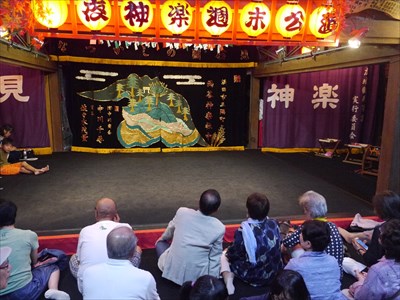
Iwami Night Kagura at Sanku Shrine
Of these, the regular performances held at Sanku Shrine in Hamada City are Kagura performances inside the shrine's worshippers' hall. The two performance will be performed from 8 to 9 pm. Although it is a tourism kagura, it is popular because you can enjoy the atmosphere close to the actual dedication kagura even though it is a short time. The number of people mobilized was 2243 in 2015, 2811 in 2016, and 3074 in 2017. If we assume that the performances are performed 40 times a year, an average of 55 to 75 people will be watching. Although this is a small number in absolute terms, it is a good number considering the size of the worshippers' hall at Sanku Shrine, and it can be said that the satisfaction level is high. There are many visitors from outside the prefecture.
Behind this Kagura promotion initiative centered on the western part of Shimane Prefecture is the "Law on Promotion of Tourism and Specified Regional Commerce and Industry by Implementing Events Utilizing Local Traditional Performing Arts," commonly known as the "Festival Law".
To put it plainly, it is a law intended for regional promotion by converting folk performing arts into tourism resources. By utilizing the folk performing arts of the area for tourism, they try to differentiate themselves from other areas and revitalize the area. Since it came into effect in 1992, more than 25 years have passed.
==Festival Law==
However, when this "Festival Law" was first enacted, it received fierce opposition from folklore scholars. One folk musicologist sternly points out that if a kagura is performed out of its original context (such as a dedication kagura), it is a kagura show. Nothing is limited to Kagura, but it also applies to folk songs, but here I would like to focus on Kagura.
The transition from "preservation" to "utilization" of folk performing arts can be seen in the festival law. In modern times, "preservation" and "utilization" are not binary oppositions, but rather two sides of the same coin. One of the reasons why the festival law was repulsed is that it is not the festival parties but the tourist agent, commercial and industrial men that take the initiative.
==Iwami Kagura and Kagura Show==
By the way, Iwami Kagura has long been criticized as a "show". The possible reasons for this are as follows.
- * It has come to be performed on the stage (co-starring convention, competition) outside the original context of dedication to the shrine. In addition, it is increasingly used for events such as performances at hotels and attracting customers at supermarkets. In short, it became the centerpiece of the business.
- * The rendition becomes viewy. For example, put out a number of orochs (* before the Osaka Expo, there were only one or two), the formation of orochs, the eyes of orochs shining with lights, sparks with gunpowder, and smoke with dry ice , Throw a cobweb (Kumo) to express witchcraft.
- * Loud with a microphone.
- * The rendition will be based on a wide stage.
- * Viewy actions such as high-speed turning (Hira-Mai dance) .
- * The ritual dance is neglected and the Noh-Mai dance is predominant.
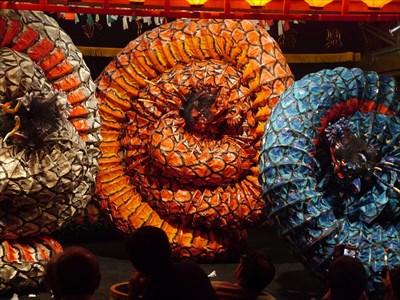
Iwami Kagura Orochi's Formation

Iwami Kagura Orochi's Formation
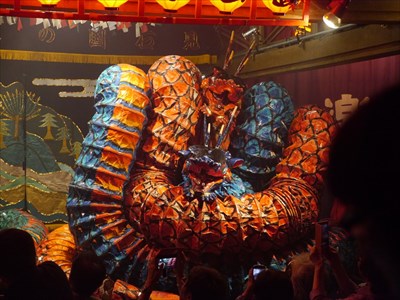
Iwami Kagura Orochi's Formation

Kanto Jindai Kagura Hitakami-Kumo throw a Kumo
These have been the case forty years ago when I was a kid, so it can be said that these have already taken root as rendition in modern times. I've never heard of a counterargument to "it's a show". At best, it's like "I'm doing it because I like it, so leave me alone." It is said that there are more than 200 Iwami Kagura companies, including Geihoku Kagura. It is certain that many of them operate on a level that has nothing to do with the evaluation of scholars or the rating of the government. In addition, Iwami Kagura was certified as a Japan Heritage in 2019. This includes Omoto Kagura.
The Law for the Protection of Cultural Properties preserved / protected individual cultural properties in terms of points. On the other hand, Japan Heritage aims to revitalize the region by connecting tangible and intangible cultural properties in a story, grasping them in terms of surface, and disseminating them. They are looking not only domestically but also inbound.
By the way, there are also people who reverse "it is a show" to "show up" and interpret it positively. Regarding the criticism that "it is a show", for example, even Take-Kagura in Iwate Prefecture, which is designated as an important intangible folk cultural property of the country, is criticized as "showing" due to an increase in performances on the stage.
Also, in tourism kagura, the digest version, which normally takes about an hour, is played in 30 minutes. If this happens, Kagura will be fragmented, and even if it is important in the performance, boring scenes will be cut off. There is also the problem of the dancer's consciousness that he cannot turn completely into a god with a small number of performances.
In competitions, the specified time is generally 35 minutes, but I personally think that this is neither long nor short and easy to see.
By the way, the Kagura company that achieved excellent results in the competition has the merit of being honored and receiving requests for dedication kagura from all over the place. For that reason, each Kagura companies improve its art.
Here, folklore scholars are worried that the essence of kagura will be lost when it becomes a spectacle and a show.
In fact, in the Showa era, many folklore was lost due to the mechanization of agriculture during the period of high economic miracle. It is the flip side of becoming rich and advancing. Folklorists have always warned against this situation with a sense of crisis.
When I was a kid, I heard criticisms such as "Iwami Kagura is a show" and "Genuine Kagura is Omoto Kagura". I've spent decades without knowing how to respond to this criticism, but as I read folklore-related treatises and books, I began to see these backgrounds.
==Essentialism and Constructionism==
The criticism that Kagura is turned into a show and undermines the essence of Kagura is based on the understanding that there is a real Kagura somewhere or the essence of Kagura.
Not limited to Kagura, I learned that the position of thinking that these cultures have a timeless and unchanging essence is called essentialism.
With respect to this essentialism, there is an idea that what has been considered to be an unchanging essence is actually influenced by the political and economic background and ideological background of that era. In other words, there is a perspective that is relativized by the historical context. It is interpreted as a culture that has been reconstructed and recreated in the context of the times. This is called constructionism.
If essentialism is static, constructionism can be called dynamic. In the field of folk performing arts, it seems that discussions began in the 1990s around the beginning of Heisei.
The reaction of folklore scholars to the festival bill mentioned above suggests that the majority of scholars are based on essentialism. On the other hand, constructionism seems to be popular among the younger generation (at that time).
This essentialist / constructionist confrontation is also a current fad, but goes back to the confrontation between realism and nominalism in scholasticism. In other words, it turns out that it is actually a deep-seated conflict that has been around for a long time.
The epistemology of constructionism states that we are not individuals, but in the web of relationships that connect us. We think that meaning arises in relationships. And suppose that the reality that surrounds us is socially composed. An idealistic epistemology influenced by postmodern ideas.
However, since there is no time to doubt everything idealistically (they do not doubt the existence of things), there is a problem that judgment must be stopped (epoché) somewhere.
It was Hobsbawm's "THe Invention of tradition" that had a major influence on folklore and cultural anthropology. The book focuses primarily on the history of Britain (Scotland, Wales or India) and points out that many of its traditions were in fact modern products. It is said that various rituals were created because it became necessary to unite the people as a nation-state in the modern era. This invented tradition has become a sign of constructionism. In addition, it is said that the influence of materialistic view can be seen in this book. It is an impression that materialism is going on a rampage in an unexpected place.
As the created tradition theory goes one step further, the traditional fabrication theory emerges. The view is that it is a fake tradition invented in modern times. It is based on essentialism in that it implicitly considers pre-modern traditions to be genuine.
==Kagura and Constructionism==
So what happens if you think of Kagura as a constructionist? Kagura was revised in the Yoshida Shinto style during the Edo period due to the influence of national studies. Furthermore, in the Meiji era, a ban on priesthood performances was issued, priests were banned from dancing kagura, and the bearers moved to the parishioners. Along with this, the olacle in the trance state was also lost. In addition, an examination system was introduced to prohibit desecrating and obscene acts of god, and to question the knowledge of ancient history and Shinto. The program we are watching actually went through such a process in the Meiji era.
Looking at Iwami Kagura in the Iwami region of Shimane Prefecture, it can be said that it goes well with constructionism. Even in Iwami Kagura, in the Meiji era, the priesthood was prohibited from dancing Kagura, so the bearer moved to the parishioner. It seems that the priesthood sometimes taught the parishioners. In addition, national scholars at that time revised the script verses from material to old-fashioned. This was to correct the collapsed verses of the oral script and to unify the script. In addition, a fast-paced musical accompaniment called eight-tone (Hattyoshi) was introduced. In other words, the eight-tone Iwami Kagura that has undergone such Kagura revisions is, so to speak, a modern product. It can be said that it is a kagura that Iwami people reconstructed according to the Meiji era. To put it simply, it is a modern kagura.
Changes have come since then. A bellows-shaped body made of bamboo and Japanese paper called a Jado (snake body) was incorporated into the program "Orochi". This Jado Orochi became popular. "Orochi", which was performed at the 1970 Osaka Expo, was a dance of eight orochs, and left a great impact. The spectacular "Orochi" has become a major performance of tourism kagura and has improved its status. This is the last performance in the co-starring conventions. By introducing the snake body, the previous performance form was lost, but it can be said to be creative destruction and innovation in Kagura.
Academically, it is classified as Iwami Kagura, but the same can be said for Geihoku Kagura in the north Aki region of Hiroshima Prefecture. Geihoku Kagura was established under the influence of Iwami Kagura, but after the war, a creative Kagura called Shinmai (New Mai dance) was born in order to avoid GHQ censorship. There are many performances of Shinmai that have nothing to do with Shinto, such as the extermination of Oni demons between Minamoto no Yorimitsu and the Big Four. Even as a dramaized kagura, there is an aspect that deviates from the mythical drama, but this new dance has dominated the north Aki region and has a history of nearly 70 years. In addition, Super Kagra has also been born.
In this way, it is clear that the Kagura in the Geihoku and Iwami regions are modern products (* the same is true for the Kanto Sato Kagura), but when constructionism becomes extreme, problems arise. There is a view that the current "uniqueness of traditional culture" is actually just a "fiction" that comes from tourism demands.
I have to argue against this. They dance because they want to dance. There is a history that the Hamada domain banned the parishioners from dancing kagura at the end of the Edo period. In other words, since the end of the Edo period, Kagura has been danced by imitating by model-learning. Then, in the Meiji era, the priesthood was prohibited from dancing the kagura, and the bearer of the kagura moved from the priesthood to the parishioner. In other words, the parishioners danced because they wanted to dance. There are no tourist requests there. Not all are "fiction".
One of the reasons why this advocate came to such an extreme theory is the creative Japanese drum (Wa-daiko). Creative Japanese drums count thousands of groups nationwide. Since it was a creation, it was launched in recent years, but now it is expected to be the core of regional revitalization. The above "fictional" remark was what he wanted to catch such an phenomenon and say, "Where is the vernacular sound?" But it's dangerous to apply it to all.
Then, do "genuine kagura" and "the essence of kagura" have to be interpreted as relativized in the historical context? Has essentialism been devalued in modern times?
There are many kagura that have undergone revisions to the verses, but it is difficult to judge because there is a view that the dance itself is not so affected.
In my opinion, in Iwami Kagura, the ritual dance called "Shio-harai" is considered to be the "essence of Iwami Kagura" (* in Geihoku Kagura, "Kami-oroshi"). It is the first performance in Kagura and has a symbolic meaning of purifying the stage and inviting a god. It is said that all the behavior of god are included, and it is a basic performance. In addition, it is said that it is an honor for the company to dance the Shio-harai at co-starring conventions and competitions. It is said that there are some companies that teach Shio-harai first and some that only veterans can dance.
In addition, the Kagura company of Geihoku Kagura teaches that "when you dance on stage, you should have the same attitude as the dedication kagura at the shrine." Although dancing on the stage of the competition has been around since the end of the war, it can be said that this attitude does not change easily.
Here, I will take up the case of Bichu Kagura in Okayama Prefecture. Okayama Prefecture will develop significantly during the postwar period of high economic miracle. I cite the increase in tourists due to the heavy industrialization in the coastal area, the extension of the Shinkansen to Okayama, and the "Discover Japan" campaign of the Japanese National Railways as premise for development.
Kagura was performed during the off-season, but as the industry shifts from the primary industry (agriculture) to the secondary industry (manufacturing industry) and the tertiary industry (service industry), performances are concentrated on weekends. In addition, as the number of tourist increased, the weight of tourism kagura increased. The Kagura show happened here as well. As a result, the number of Kagura Tayu (Kagura Master) who danced Kagura was insufficient, and dancers with inexperienced skills were to dance on the stage. In addition, the number of kagura clubs has increased, and the number of people who can dance kagura has increased, but the quality has been on a downward trend.
Veteran Kagura Master with more than 50 years of Kagura history who could not see these situations gathered and started an activity to bring together each other's knowledge and skills and collaborate to seek "correct Kagura".
The Kagura Master say, "Mr. XX was dancing like this," not only in his own words, but also in the example of the masters they studied. It is the transmission of knowledge in hearsay format. By widely sharing the knowledge and skills that had been passed down in the family through the teacher-apprentice relationship, it will be passed on to other Kagura companies.
These hearsays can only be traced back to one or two generations ago of the current veteran Kagura Master, but they are continuing their activities to seek "correct kagura" and "the essence of kagura." Although there are limits, it may be called "authentic Kagura". It can be likened to the strategic essentialism of cultural anthropology. It can be said that Bichu Kagura is being standardized depending on the viewpoint.
On the other hand, from the standpoint of constructionism, it is true that the "authenticity" is only interpreted by Kagura Master at the present time. When constructionism is scrutinized, traditional culture is neither genuine nor fake, when everything is just a matter of interpretation. Then, I would like to ask again that both folklore and cultural anthropology will be reduced to just confirming the current situation. No, it finds the independence and creativity of the people involved in traditional culture there (this is called the independence version of constructionism or the objectification of culture) ... and as a result, The uniqueness of the traditional culture given by the subject does not end with a one-time explanation, but is always required to be explained. In other words, everything is fictional ... and these discussions go round and round.
Anyway, when constructionism is scrutinized, there is no real or fake culture, that is, anything. I think it's really wrong.
Due to the power relationship of dominate / dominated in colonialism in cultural anthropology, there are festivals founded by indigenous peoples under the influence of rulers after colonial rule, such as Kecak in Bali. Therefore, it is persuasive to respect the independence of indigenous peoples and to say that there is neither genuine nor fake in culture. However, with the exception of Hokkaido and Okinawa, folklore, especially Japanese folklore advocating one national folklore, comes to the conclusion that there is neither genuine nor fake in culture, it is just a confirmation of the current situation without an aesthetic eye.
In my opinion, the objectification theory of culture (making the culture an object that can be manipulated by separating it from the original context, and the controlled side taking the initiative in the objectified culture) has a double meaning. The ruler excuses because the history of colonial rule cannot be overturned. And, although it is a limited range, the controlling side excuses the controlled side because it is demonstrating independence. These have some sort of duality. In some cases, I think it's a very convenient theory. I can read, "I acknowledge your efforts, but you can't overturn the history of colonial rule".
On the other hand, the drawback of essentialism is that it does not allow the historical transformation of performing arts. So to speak, in pursuit of the illusion of idealized and purified kagura, they are not seeing the kagura as it is. It is two sides of the same coin with authoritarianism.
For example, Nakano Nanazu Mai in Iwate Prefecture has adopted a modern practice method such as "raising your hand about 60 degrees" while the usual traditional performing arts are repeated by looking at and imitating them. At a certain folk performing arts symposium, Nakano Nanazu mai was performed along with the practice scene, but Kagura researcher Masaru Iwata categorized it as "girl opera." You can see Iwata, who became an authority in the study of Kagura.
We classify "should be" as a proposition for the purpose (Sollen) and "is" as a proposition for existence (sein), but existence (sein) and purpose (sollen) are different. The essentialist view of performing arts seems to distort the perception that the "should (sollen)" theory precedes the "is (sein)" theory.
So I can't be on the side of either essentialism or constructionism. There are advantages and disadvantages.
==Kagura Master==
Bichu Kagura was originally learned through an apprenticeship master-discipleship relationship. Currently, in addition to the above efforts, efforts such as raising children's kagura are being made.
In Kanto Sato Kagura, Kagura is handed down under the Iemoto (patriarch) system. It is a system supported by the authority of the Iemoto. There used to be professional kagura masters, but now they have a side job. And in Kanto, Motojime (organizer) is bundling Kagura masters. In the case of the Motojime system, it seems that today there are people who can perform XX, so they will try to do XX.
Iwami Kagura and Geihoku Kagura are not professionalized either. In many places, there are companies that perform 40 to 50 times a year, but all the members are part-time jobs. In particular, it costs money for costumes, so it is not considered to be profitable.
In addition, Iwami Kagura Tokyo and Osaka company have been formed and are making efforts to introduce Iwami Kagura in urban areas. Today, they have been entrusted with dedication kagura. However, in the case of Kanto, there is concern that the more active it is, the more it will erode the territory of the existing company. There shouldn't be any local companies in Osaka that play Noh Mai, so I don't think there's any concern about that.
==folklorism==
By the way, performing arts such as kagura may be performed as an event held on a stage such as a co-starring convention, leaving the original context (* dedication kagura in kagura). This means that a new secondary meaning has been added to the original meaning. It means that performing arts accompanied by faith and piety will be appreciated exclusively from a tourist and aesthetic point of view. That is, the second-hand. This is the second-hand for the first-hand. In German folklore, this kind of pseudo-folklore culture is called folklorismus (English: folklorism), and it is said that it is now an important academic concept. Translated literally, folklorismus is like folklore. It is a binary opposition between "pure folk culture" and "pseudo-folklorism", but this a priori perception of "pure folk culture" needs to be corrected.
Folklore does not talk about why folklorism attracts people in spite of the second hand. Is it because it provides what tourists want with convenience suitable for sightseeing? However, I feel that it is the answer of tourism, not the answer of folklore. Or is it self-evident?
I was shown the results of a questionnaire to Kagura masters taken after the second performance of "Kanagawa no Okagura". The questionnaire asked Kagura masters about the difference between dedication kagura and on-stage theater performances. There was an answer that was conscious of the strength of the eyes of the audience at the theater performance. This person was a veteran Kagura master, and he answered that he didn't care about the number of spectators on the day (* the venue was full on the day). In fact, many respondents said they were "conscious." The audience are all watching the stage, probably because it is a paid performance or because they can concentrate on Kagura. These seem to have stated that. Therefore, it seems that the Kagura master does not lose their motivation just because the theater performance is in the absence of god.
When it comes to theater performances, it is the second hand for dedication kagura, which is also pointed out as folklorism, but the result was that there was not much difference in the awareness of the parties' performances.
Performances in theaters have the secondary benefits of not having to worry about the weather, being able to watch in a comfortable, air-conditioned space, and not having to worry about the toilet. It does not matter if tourists visit the dedication kagura, but there are drawbacks such as no parking lot, no large number of people, and some shrines do not have toilets. The theater is better suited to accommodate a large audience. Although it is a second hand in which god is absent, theater kagura has the effect of making it easier to participate in kagura and expanding its base.
For the criticism that "it's a show", this also looks like some sort of labeling. Compared to a similar criticism of "commercialism" in theater, theater can be seen as a binary opposition between artistry and commercialism. And it is commercialization that puts the capitalist principle of action of pursuing profit first. In fact, this is backed by mass society theory. There is criticism that it is a ready-made, homogeneous, uniform, stereotype popular culture (mass culture) that is offered to the masses who have been popularized and have lost the power to create their own culture.
In addition, the high economic miracle of the Showa era has made it materially rich, but that is not directly linked to the richness of the mind. Therefore, something that satisfies the richness of the mind is required. I think people who are not satisfied with such mass culture seek art and performing arts.
In the case of modern folk performing arts, the performing arts themselves will not be profitable. In that respect, the criticism of commercialism does not apply, but on the other hand, if we draw the auxiliary line of mass society, the folk performing arts there are under pressure from mass culture such as television, radio, and movies. Folk performing arts have lost their pre-mass socialization activity. Nostalgia is what people want from such folk performing arts. It seems that the current folk performing arts have become folklorism as a handy second hand that satisfies nostalgia.
In summary, folklorism, such as theater kagura in the absence of god, is a secondary context to the original context of dedication kagura, the second hand. However, folklorism evokes the nostalgia of the audience in today's mass-socialized world. It will also plant future nostalgia seeds for young people. Moreover, it can be said that it has the effect of making it easier to participate in Kagura and expanding the base.
However, there are also modern folklorisms that cannot be explained by nostalgia, such as festivals in cities where god is absent, such as Sapporo's Yosakoi Soran. Therefore, it is not a perfect answer. Or is it Bauzinger's internal exoticism? By the way, YOSAKOI Soran in Sapporo is the second hand of the Yosakoi Festival in Kochi City. In other words, it is also the second hand of Awa Odori in Tokushima.
==Summary==
The reason why Kagura is dedicated in the first place is probably to thank the gods for a good harvest during the autumn festival season. For reference, if you look at the origin of the peasant kagura described in Osuke Misonou's "Study of the Bocho Kagura", it is as follows.
- I. An attempt to avoid a series of deaths due to an epidemic.
- 2. A prayer for safe rice cultivation and mild weather so that the five grains will not grow due to unseasonable weather and many peasants will not starve to death.
- 3. rain-making ritual.
- 4. The vengeful spirit of those who have died unusually, that is, Misaki is calmed down, and when the people who have suffered a great disaster starve to death, this is used as a haunting of the demon to calm Misaki.
- 5. The origin of the so-called ancestor worship, in which the family worships the gods and dedicates kagura in order to unite the affinity.
- 6. A priest who has nothing to do with the inhabitants came and taught.
(Pages 59-60)
Excluding six, the above reasons can be mentioned. This is an example of Yamaguchi Prefecture, but I think that this is generally the case in the Chugoku region. Kagura has been made into a play, and the emphasis has shifted from ritual dance to Noh Mai dance, and as the times went down, it seems that it has become more aesthetically pleasing.
Certainly, when you look at the pictures of Geihoku Kagura, you can see them on the stage in gorgeous costumes. Shinmai (New Mai dance), who wears heavy costumes and dances intensely, is gorgeous and beautiful from an aesthetic point of view. On the other hand, there is a deviation from the mythical drama. It can be said that it is the most cutting-edge kagura. However, it is not strange that there is an opinion that "wait a minute".
It is a deviation from the mythical drama, but on the flip side, it can be interpreted that Kagura has achieved dramatic development by avoiding the restrictions of the mythical drama. However, on the other hand, it is biased toward battle-specific content, so it may be said that the direction of development is limited in that respect.
Eight-tone Iwami Kagura and Geihoku Kagura are living kagura that are still changing. In a sense, these are the most advanced kagura, so I think it is meaningful to consider such trends. And these kagura are now also the identities of the region.
Finally, the essentialist / constructionist conflict is deep-seated and difficult for the layperson to sublate. If anyone could do it, it would be a great success as a scholar. It's been decades since I heard the criticism that "Iwami Kagura is a show," but I have the impression that it has finally reached the core. However, it is also a fact that it expands academically infinitely from there. From now on, I would like to work patiently.
==Finally==
That's all I can write about Kagura now. The content is particular about the critical word "show". For the time being, I intend to consider where to start and the trends in folklore since the beginning of the 1990's. In addition, important kagura such as Shimotsuki Kagura in Mikawa, South-Shinano, Totomi region and Yamabushi Kagura in Tohoku are thin and biased towards Izumo style Kagura, but please forgive me. Seeing is believing, rather than arranging the logic in a row. The video has been uploaded to the internet, so feel free to search for it. If you have a chance, please visit the dedication kagura. Kagura is not something you look at in awe, you can drink alcohol. When taking a picture, do not use the flash.
==References==
- *『西日本諸神楽の研究』(石塚尊俊、慶友社、1979)
- *『里神楽の成立に関する研究』(石塚尊俊、岩田書院、2005)* About Shiromi Kagura, "Mountain God".
- *『出雲神楽 出雲市民文庫17』(石塚尊俊、出雲市教育委員会、2001)* About "Mountain God"
- *『神楽と神がかり』(牛尾三千夫、名著出版、1985)
- *『神楽源流考』(岩田勝、名著出版、1983)
- *『神楽新考』(岩田勝、名著出版、1992)* There is an interpretation of Iwato myth.
- *『本田安次著作集 日本の伝統芸能 第一巻 神楽Ⅰ』(本田安次、錦正社、1993)* Overview of Kagura nationwide.
- *『本田安次著作集 日本の伝統芸能 第二巻 神楽Ⅱ』(本田安次、錦正社、1993)* Overview of Kagura nationwide and a collection of historical materials.
- *『本田安次著作集 日本の伝統芸能 第三巻 神楽Ⅲ』(本田安次、錦正社、1994)* A collection of historical materials of Kagura nationwide.
- *『神楽研究』(西角井正慶、壬生書院、1934)
- *『日本民俗選集 第16巻 官国幣社特殊神事調 芸術としての神楽の研究 小寺融吉 著』(小川直之/編、クレス出版、2010)
- *『かぐら台本集』(佐々木順三、佐々木敬文、2016)* Script collection of Geihoku Kagura
- *『校訂石見神楽台本』(篠原實/編、1982)
- *『考訂 芸北神楽台本Ⅱ 旧舞の里山県郡西部編』(佐々木浩、加計印刷、2011)* Old Mai's oral script. A script not found in "the revised Iwami Kagura script" is recorded.
- *『日中比較芸能史』(諏訪春雄、吉川弘文館、1994)* About Masaru Iwata's Kagura theory. There is an article about the comparison between Japan and China of Prince Goro. There is a comparison with the Hana-matsuri (flower festival) in Maudgalyayana play.
- *『霜月神楽の祝祭学』(井上隆弘、岩田書院、2004)※岩田勝の神楽理論を検証。
- *『日本庶民文化史料集成 第1巻 神楽・舞楽』(芸能史研究会/編、三一書房、1974)* Includes Bingo Tojo Kojin Kagura Noh book. There are also scripts for Omoto Kagura and six-tone Iwami Kagura. Arahira's script is included in the Geihoku Kagura Noh book collection. It can be seen that Arahira was dancing in the 16th century in the Geihoku region.
- *『中国地方民間神楽祭祀の研究』(三村泰臣、岩田書院、2010)
- *『大荒神頌 シリーズ〈物語の誕生〉』(山本ひろ子、岩波書店、1993)* About Princess Goro. Others, such as Prince Kirime.
- *『花祭』(早川孝太郎、角川書店、2017)
- *『新・神楽と出会う本 歌・楽器・お囃子』(三上敏視、アルテスパブリッシング、2017)* Pointed out that Iwami Kagura will reach BPM 200. Besides, about improved flute and Kagura song. Also suitable as an introductory book for Kagura.
- *『早池峰岳神楽 舞の象徴と社会的実践』(長澤壮平、岩田書院、2009)* There are criticisms that the number of performances on the stage of Take Kagura has increased and that it has become a show.
- *『神楽の芸能民俗的研究』(久保田裕道、おうふう、一九九九)* A discussion of Hayachine Kagura in the Tohoku region and Shimotsuki Kagura in the Southern Alps.
- *『荒神とミサキ―岡山県の民間信仰―』(三浦秀宥、名著出版、1989)
- *『石見神楽』(矢富巌夫、山陰中央新報社、1985)* "Gojin" is called "farmer's Philosophy".
- *『今を生きる日本の伝統芸能 江戸太神楽』(丸一仙翁、散太郎神楽出版、2016)
- *『防長神楽の研究』(御薗生翁甫、未来社、1972)
- *『椎葉神楽発掘』(渡辺伸夫、岩田書院、2012)
- * 『花祭りの起源 死・地獄・再生の大神楽』(山﨑一司、岩田書院、2012)
- *『折口信夫の鎮魂論 研究史的位相と歌人の身体感覚』(津城寛文、春秋社、1990)
- *『民俗芸能研究という神話』(橋本裕之、森話社、2006)* About the aesthetic approach of "Study of Kagura as Art". In addition, there is Michio Ushio theory.
- *『震災と芸能 地域再生の原動力』(橋本裕之、追手門大学出版会、2015)* About Unotori Kagura in Iwate Prefecture.
- *『トランスポジションの思想―文化人類学の再想像―』(太田好信、世界思想社、2010)* About demonstrating independence in culture under the relationship of dominating / controlled. The objectification theory of culture.
- *『舞台の上の文化 まつり・民俗芸能・博物館』(橋本裕之、追手門大学出版会、2014)* About the Law for the Protection of Cultural Properties and the Festival Law.
- *『あなたの社会構成主義』(ケネス・J・ガーゲン、東村知子/訳、ナカニシヤ出版、二〇〇四)* An introductory book on social constructionism. A simple explanation of the formation of constructionism and its epistemology.
- *『創られた伝統』(エリック・ホブズボウム、テレンス・レンジャー/編、前川啓治、梶原景昭 他/訳、紀伊国屋書店、1992)* About modern British history. It is pointed out that rituals, which were traditionally regarded as traditional, are surprisingly modern products. Although it is not directly related to Kagura, I will mention it because it is a book that has become a sign of constructionism.
- *『現代演劇のフィールドワーク 芸術生産の文化社会学』(佐藤郁哉、東京大学出版会、1999)* Verify the criticism of commercialization of small theater theater.
- *『「よさこい系」祭りの都市民俗学』(矢島妙子、岩田書院、2015)* About YOSAKOI Soran in Sapporo. See the commentary on folklorism.
- *『フォークロリズムから見た今日の民俗文化』(河野眞、創土社、2012)*Bouzinger points out internal exoticism about folklorism.
- * 藤原宏夫「石見神楽における六調子と八調子―その定義と八調子の成立について―」『民俗芸能研究』第43号(民俗芸能学会、2007)80―96頁。* Consideration on the classification of Iwami Kagura's six and eight tones.
- * 俵木悟『八頭の大蛇が辿ってきた道―石見神楽「大蛇」の大阪万博出演とその影響―』『石見神楽の創造性に関する研究』(島根県古代文化センター、2013)* About the history of Iwami Kagura's appearance at the Osaka Expo.
- * 石塚尊俊「五行神楽の分布と源流」『芸能論纂』(本田安次博士古稀記念会/編、錦正社、1976)249―63頁。
- * 田中重雄「五行祭盛衰記」『広島民俗』第18号(広島民俗学会、1982)1―6頁。* About the five elements of Bingo Kagura. A professional kagura master served as a kagura master, but it declined rapidly in the 1955's.
- * 井上隆弘「神楽における死霊祭祀―山口県山代地方の山鎮神楽について―」『佛教大学総合研究所共同研究成果報告論文集』6号(佛教大学総合研究所、2018)17―34頁。* About "Shogun Mai".
- * 萩原龍夫「大元神楽見学記」『神々と村落 : 歴史学と民俗学との接点』(萩原龍夫、弘文堂、2014)167―183頁。* About Takudayu's oracle.
- * 岩田勝「牛尾神楽学を継承していくために」『広島民俗』第26号(牛尾三千夫先生追悼号)(広島民俗学会、1987)* About editing "Kagura and Kamigakari".
- * 田中重雄「岩田勝さんを惜しむ」『広島民俗』第42号(広島民俗学会、1994)39―45頁。* About the biography of Masaru Iwata.
- * 山路興造「もう一つの猿楽能―修験の持ち伝えた能について―」『芸能史研究』44号(芸能史研究会、1974)35―48頁。* It is considered that the style of Noh before success of Noh is left in the Bingo Tojo Kojin Kagura Noh book.
- * 西郷由布子「芸能を<身につける>―山伏神楽の習得過程」『身体の構築学―社会的学習過程としての身体技法』(福島真人/編、ひつじ書房、1995)101―141頁。* It is analyzed that the dance of Hayachine Kagura is composed of units called Tegoto.
- * 迫俊道「芸北神楽におけるフロー」『フロー理論の展開』(今村浩明、浅川希洋志/編、世界思想社、2003)* The case where "Jinrin" was NG due to GHQ censorship.
- * 井上隆弘「神楽祭文研究の方法について―岩田勝・山本ひろ子の所説を中心として―」『民俗芸能研究』59号(民俗芸能学会編集委員会/編、2015)26―44頁。
- * 森林憲史「関東地方の神楽囃子について―楽曲から神楽の系譜を辿る試み―」『民俗芸能研究』第42号(民俗芸能学会, 2007)41―81頁。* Pointed out that there is a Henbai (magical step) in Kanto Sato Kagura.
- * 藤村和宏「地域伝統芸能の継承と変容が市場創造に及ぼす影響に関する考察―島根県の3地域における神楽をケースとして―」『香川大学経済論叢』84(4)(香川大学経済研究所/編、012)293―379頁。* Regarding Kagura in Shimane Prefecture, the idea is to first guide the Kagura to the more entertaining Iwami Kagura, and then to the more authentic Izumo Kagura and Oki Kagura.
- * 迫俊道「伝統芸能の継承についての一考察―広島市における神楽の事例から―」『大阪商業大学』第5巻第1号(通巻151・152号合併号)(大阪商業大学商経学会、2009)609―621頁。* There is an interview with the Kagura company that incorporated Geihoku Kagura into its repertoire at Aki Juni Jingi.
- * 水上勲「《塵輪》《牛鬼》伝説考―「新羅」来襲伝説と瀬戸内の妖怪伝承―」『帝塚山大学人文科学部紀要』第18号(帝塚山大学人文科学部紀、2005)19―37頁。
- * 山﨑達哉「佐陀神能の変化とその要因に関する研究―神事と芸能の二面性―」『待兼山論叢 50 文化動態論篇』(大阪大学大学院研究科, 2016)pp.1-34
- * 笹原亮二「民俗芸能大会というもの―演じる人々・観る人々―」『課題としての民俗芸能研究』(民俗芸能研究の会/第一民俗芸能学会/編, ひつじ書房, 1993)pp.395-422
- * 川野祐一朗「民俗芸能を取り巻く視線―広島県の観光神楽をいかに理解すべきなのか」『森羅万象のささやき 民俗宗教研究の諸相』(鈴木正崇/編、風響社、2015)711―728頁。* Consideration of Geihoku Kagura, which is sometimes criticized as a "show". He points out the attitude of Geihoku Kagura, "When you dance on stage, it's the same as when you dance at a shrine."
- * 新谷尚紀『映像民俗誌論―「芸北神楽民俗誌」とその制作の現場から』『歴博大学院セミナー「民俗学の資料論」』国立歴史民俗博物館/編、吉川弘文館、1999)* About the background of the Nakakawado company's Super Kagura.
- * 「シンポジウム『民俗芸能とおまつり法』」『民俗芸能研究』17(民俗芸能学会編集委員会/編、民俗芸能学会、1993)78―97頁。* Symposium on the festival law. Also, about the designation of folk performing arts as a cultural property. Save "Parts that must not be changed".
- * 小島美子「民俗芸能が観光の材料にされる!!」『芸能』34(3)397(芸能学会/編、1992)62頁。* If folk performing arts are performed on stage, it will be severely pointed out that it is a show.
- * 茂木栄「伝統芸能のイベント活用法案について」『民俗芸能学会会報』第22号(民俗芸能学会、1992)2―3頁。* About the festival law.
- * 足立重和「伝統文化の説明―郡上おどりの保存をめぐって」『歴史的環境の社会学 シリーズ環境社会学3』(片岡新自/編、新曜社、2000)132―154頁。* Criticism of the independent version of cultural constructivism. He also points out that the uniqueness of modern traditional culture is nothing more than a fiction that comes from tourism demands.
- * 足立重和「伝統文化の管理人 郡上おどりの保存をめぐる郷土史家の言説実践」『社会構築主義のスペクトラム―パースペクティブの現在と可能性―』(中河伸俊、北澤毅、土井隆義/編、ナカニシヤ出版、2001)175―195頁。* Criticism of the independent version of cultural constructivism. He also points out that the uniqueness of modern traditional culture is nothing more than a fiction that comes from tourism demands.
- * 八木康幸「郷土芸能としての和太鼓」『たいころじい』15号(十月社、1997)17―25頁。* About creative Japanese drums.
- * 才津祐美子「そして民俗芸能は文化財になった」『たいころじい』15号(十月社、1997)26―32頁。* About cultural property protection administration. About how intangible folk cultural properties, which were considered unsuitable for preservation because they change with the times, were preserved under the Law for the Protection of Cultural Properties.
- * 俵木悟『「正しい神楽」を求めて―備中神楽の内省的な伝承活動に関する考察―」『日本常民文化紀要』第33輯(成城大学大学院文学研究科、2018)53―93頁。* About the movement for "correct Kagura" of Bichu Kagura.
- * 太田好信「文化の客体化―観光をとおした文化とアイデンティティの創造」『民族学研究』57―4(民続学会、1993)383―410頁。* About the exercise of independence in the culture of those who dominate / controlled relationship.
- * 岩田勝「シンポジウム雑感」『民俗芸能研究』18号(民俗芸能学会編集委員会/編、1993)76―78頁。* Nakano Nanazu Mai is cut off as "Girls Opera".
- * 「シンポジウム 民俗芸能の継承・断絶・再生」『民俗芸能研究』18(民俗芸能学会編集委員会/編、民俗芸能学会、1993)22―51頁。* Nakano Nanazu mai is taken up.
- * 門田岳久「フォーラム ドイツ民俗学の転機とフォークロリスムス―バウジンガー著『科学技術世界のなかの民俗文化』を読んで―」『日本民俗学』232(日本民俗学会、2002)139―145頁。
- * 八木康幸「フェイクロアとフォークロリズムについての覚え書き―アメリカ民俗学における議論を中心にして―」『日本民俗学』236(日本民俗学会、2003)20―48頁。
- * ハンス・モーザー, 河野眞/訳「民俗学の研究課題としてのフォークロリスムス(上)」『愛知大学国際問題研究所紀要』90(愛知大学国際問題研究所、1989)63―95(二三二―二六四)頁。* Source of folklorism. He points out that many German folklore traditions that were thought to continue from ancient times actually began in the early modern period.
- * ハンス・モーザー, 河野眞/訳「民俗学の研究課題としてのフォークロリスムス(下)」『愛知大学国際問題研究所紀要』91(愛知大学国際問題研究所、1990)1―35(214―248)頁。* Source of folklorism. He points out that many German folklore traditions that were thought to continue from ancient times actually began in the early modern period.
- * 河野眞「ナトゥラリズムとシニシズムの彼方―フォークロリズムの理解のために(1)―」『文明21』19号(愛知大学国際コミュニケーション学会/編、2007)37―53頁。* Explain that folklorism is not a term for value judgment.
- * リチャード・ハンドラー, ジョスリン・リネキン, 川森博司/訳「伝統、本物か? にせ物か?」『世間話研究』第6号(世間話研究会、1995)1―25頁。* Taking Quebec and Hawaii as examples, it is assumed that there is no genuine or fake tradition.
- * リチャード・ハンドラー, ジョスリン・リネキン「本物の伝統、偽物の伝統」『民俗学の政治性―アメリカ民俗学100年目の省察から』(岩竹美加子、未来社、1996)125―157頁。* Another translation of "Tradition, Genuine or Spurious"
- * 芝村龍太「地域の活性化と文化の再編成―串原の組の太鼓と中山太鼓―」『ソシオロジ』135(社会学研究会、1999)21―37頁。* Regarding constructionism, he points out that if there is no genuine or fake culture, it can only be handled monotonously.
- * 岩田勝「“神々の乱舞”全国神楽フェスティバル」『民俗芸能学会会報』第21号(民俗芸能学会、1991)2―3頁。* Iwata's view of Orochi has been expressed.
- * 小田亮「文化の本質主義と構築主義を超えて」『日本常民文化紀要』20号(成城大学大学院文学研究科)111―173頁。* In-depth consideration of the objectification theory of culture in cultural anthropology.
- * 日隈健壬「いわゆるいまの『ひろしま神楽』の今日的位相」『広島修大論集』第50巻第1号(広島修道大学学術交流センター、2009)71―96頁。
- * 『第二回かながわのお神楽公演解説プログラム』(江戸里神楽公演学生実行委員会、第二回かながわのお神楽公演実行委員会、2019)
- * 『2017年度 文教大学生活科学研究所 特別公開講座 地域に伝わる伝統芸能 神楽の魅力と課題』(斉藤修平/構成、文教大学生活科学研究所、2017)* Regarding the Kagura song of Kanto Sato Kagura, it is assumed that the Kagura song was stopped due to the Kagura revision in the Meiji era.